PROLOGUE TO FURTHER THOUGHTS II
Jacques Franck, painter/draughtsman and art historian specialist in Leonardo da Vinci’s evolved painting techniques, explores the conceptual limitations and the resulting adverse consequences (i. e. damaging restorations and mis-attributed works) of art historical studies and scientific essays that are today being made without duly informed consideration of actual historical artistic practices.
Old master technical studies. The impact of artistic-technical ignorance on the works’ attribution and restoration
I – Common confusion between connoisseurship and the knowledge of art acquired through practice
When a painter trained in the academic/classical tradition – and being, therefore, an experienced and skilled copyist – visually examines an old master painting, a mental engagement occurs which instantaneously brings to mind sequenced images representing the artistic and technical process followed by the creator, a process that can easily be identified because of a familiarity gained through years of practice. A similar phenomenon occurs when musicians read a score without playing it: they can “hear” the written sounds and melodies while visualizing the technical and musical means necessary to their own performances. However, although they usually deal with old master expertise, neither art historians nor scientists practice the arts of drawing and painting, bar in exceptional cases. For that reason, their visual appraisal of the specifically technical elements presented in a painting are formulated on no sure and practical knowledge of the various artistic and technical gestures whereby they were produced. Such experts, being so remote from the creative process, can only grasp artistic, technical and material realities through their imagination and whatever objective data might have been supplied by scientific imaging and laboratory tests. In other words, such specialists are strangers to what is at the heart of creation, to its intimacies, shall we say, and they cannot but confound their own imagined and partial perceptions with the realities of the creative process itself. That so very few art historians or museum scientists recognise the impossibility of knowing what art is really about without having engaged in making it is exclusive to the visual arts today. Such handicaps could never arise in the world of music because no sensible person thinks serious musical knowledge can be obtained without years of training and the steady practice of a specific instrument. In the visual arts this extraordinary shortcoming creates maximal risks of errors: in matters of art attribution, the vital distinctions between one creative hand and another are too subtle; in matters of conservation, the master’s art and techniques are commonly misunderstood – and nowhere more so than with that of Leonardo da Vinci. In no small measure, the modern-day visual art malaise is product of a system in which the artist – the party holding a unique expertise and insight – is granted no institutional recognition when precisely such knowledge, purely factual and not theoretical, is irreplaceable in art expertise.
That is why, as early as 1998 in my essay on artistic training published in Coré, a conservation review edited by the French section of the IIC, I recommended that students in art history should be trained in art and acquainted with the elementary notions of both traditional drawing and painting in order that their approach to the discipline lies on pragmatic specialized grounds rather than on vague, unverified concepts in matters of art making, as are exemplified below [ 1].
II – Disturbing ignorance
There of course exist a number of art specialists whose visual acuity and methodology of research are excellent, but they are getting fewer and fewer (for reasons not examined here). Sadly, tangible evidence exists also of the ignorance of some leading experts regarding the elementary grounds of traditional painting techniques inherited from the Renaissance, to which Leonardo’s art practice belongs. On that particular issue, for instance, in a 2019 documentary movie broadcast world-wide, an otherwise well-meaning Louvre Museum curator interviewed about Leonardo’s sfumato technique provided a staggering explanation that revealed an ignorance of the fact that, in the oil process, when it is laid on the support (canvas or wood typically), the paint material itself (pigments + binder) should first be diluted to a suitable degree with a fluxing agent – i.e. a solvent (turpentine in the case in point) [2]. The presented extravagant hypothesis in question was addressing the ravishing, subtle, flesh sections in Leonardo’s Louvre St. Anne and the Mona Lisa, on a conviction that pigments and oil alone were used. In terms of practice, it amounts to an insolvable technical problem inasmuch as the rheology of the presumed material to be handled for achieving impalpable effects like those seen in the Louvre Leonardos is a major impediment: such a sticky and oily paint is, structurally, far too unruly to be appropriate for that kind of ultra-delicate work. Thanks to my own researches – now confirmed by Philippe Walter and Laurence de Viguerie (see Further Thoughts II) – it is an established fact that Leonardo used to superimpose in the flesh sections of the above-mentioned works numerous microlayers of very liquid paint according to material principles close to the watercolour technique, except for the fact that, in this particular case, the fluxing agent was turpentine and not water. In truth, our museum curator should have known better: it is an obvious fact, noticeable by any ordinary museum visitor, that, during the Renaissance until the late 19th century, the most part of paintings was executed using diluted paint as testified by the flat, even sections still observable in them to date. The zones of the compositions, however limited in terms of surface, in which pure oil was added to the paint are the glazed ones, and the sections where non diluted, thick pasty paint, is encountered are those ones executed in impasto, a technical process which was notably employed for the treatment of highlights and for the demonstration of the spontaneity and virtuosic quality of the artist’s brush. To be more precise, it should be added that no stricto sensu glazes (transparent layers) were used then for modelling in the flesh sections, but, instead, thin veils of translucent paint [3]. Misinterpretations regarding art practice such as reported here are commonplace in the field of connoisseurship and, in themselves, have no a priori serious importance. Yet, in the case of Leonardo’s late works it has one indeed because, in the event of cleaning, their very low oil-content paint film is at far greater risk under solvent action. [4]. It certainly is not advisable, therefore, that misleading information should be in circulation in the international museum sphere about the technique used for the making of such universal masterpieces. Erroneous preconceived views should never sanction or influence restorations.
III – Scientists can be wrong
Although nobody can reasonably contest the necessity and global efficiency of laboratory tests in matter of old master expertise, it must be admitted that science cannot resolve all the problems raised by this discipline, and especially so when studying aspects in connection with the creative technical gestures. In effect, except for rare cases, the relating researches are made without any advice from an experimented painter, who, alone, can help to spot the data needing specific investigations and likely to let emerge significant observations worth in-depth examination and susceptible, also, to be ultimately interpreted correctly. For example, the highly artistic value of Leonardo’s paintings forbids any material sampling in crucial sections such as the flesh areas. If, nevertheless, some sampling is done, the paint materials can but come from sections of lesser importance: the information thus obtained will therefore testify to a local situation and should not serve, as is so often encountered in various technical essays, to describe the work’s global flesh technique (which can vary considerably from one area to another) [5].
The recent evolution of the scientific methods of investigation now allows the analysis of paint films without removing any material from the works and without any destruction of the pigments either. It is, in particular, the case with X-ray fluorescence (XRF) and the spectrophotometric approach to colour. However, the data obtained with such means are far from being 100% reliable. The Louvre’s laboratory (C2RMF) recently – albeit discretely – admitted the fact regarding the XRF analysis points checked off on the Mona Lisa in 2004-2006: the scientists had detected the presence of burnt umber in Mona Lisa’s face [6] (Figs. 1 and 2). I was very astonished by the unseemliness of this observation, for the use of burnt umber and of that pigment quite specially, is most improbable in the flesh sections of a Leonardo painting. It overruns the places where it is used, notably the modelled fresh hues making the lovely transitions between light and shade in a face; it produces as well a dirty looking greyish-bluish tone when mixed with lead white (a basic pigment in flesh painting) and cannot be suppressed easily since it still comes up visually to some extent when an opaque layer is laid over it. This pigment is definitely unusable in the very subtly depicted flesh tints and, consequently, when it is employed, it is strictly reserved for the darkest shadows close to black. Whatever the case, in 2004-2006 it was said to have been “found” by XRF analysis in areas such as the “light flesh tint, and in the left cheek”, the “strong flesh tint in the left cheek”, the “very dark flesh tint in the left cheek”, the “darkest flesh tint in the left cheek, just before the hair” [7] (Figs. 1 and 2). In the same book, while not very clear in hypothesizing the presence of burnt umber, the spectrophotometry approach to colour states that “it seems likely that [burnt umber] was the basis of the sfumato effect that Leonardo used in the Mona Lisa’s flesh tints in order to suggest the relief by softening the contours and creating subtle chromatic transitions” [8]. Such a pigment composition was formally denied thirteen years later by the same laboratory in an essay published in the catalogue of the commemorative Leonardo exhibition held at the Louvre in October 2019: “the latter pigment has been mentioned many times [by the C2RMF in 2004-2006] based on an elliptic interpretation of XRF test results. Nevertheless, no mention of burnt umber has been found in [Leonardo’s manuscripts] and no explicit identification of this pigment has been obtained [by us] until now in the analysis of the flesh zones of the [Louvre Leonardos]” [9]. It is worth noting that the book containing those wrong observations, despite the bold title of the French edition – which translates “Inside The Mona Lisa. Leonardo da Vinci decoded ” (“Au coeur de La Joconde. Léonard de Vinci décodé”) – has been spread and cited world-wide since 2006.
Above, Fig. 1: [After Paris, 2006, Fig. 146, p. 88] Areas analysed by X-ray fluorescence (see Fig. 148, p. 89 below), detail showing the areas said to contain burnt umber.
Above, Fig. 2: [After Paris, 2006, Fig. 148, p. 89] The Mona Lisa: location of areas (in red) said to contain burnt umber, analysed by X-ray fluorescence (XRF).
Burnt umber was not only said to have been “found” in the Mona Lisa in these years by XRF and by the spectrophotometry approach to colour but also by another non-destructive type of research of 2008 using a multispectral camera and a calculation system called the “radiative transfer equation” [10]. Those conclusions were so simplistic with regard to the complexity of Leonardo’s flesh technique in the legendary masterpiece that I contested their pertinence in a note to the authors and I exchanged directly with one of them (the engineer, Pascal Cotte) about the dubious claimed presence of burnt umber in those sections of the painting [11] (Fig. 3). Thus, there would be sufficient reasons to try and understand the enigma whereby burnt umber was wrongly detected through different methods of approach insofar as another, much deeper investigation on the materials used by da Vinci in the Louvre Leonardos, had been produced by the then C2RMF scientists Philippe Walter and Laurence de Viguerie (see Further Thoughts II), and had identified this pigment not only in the Mona Lisa but in the Saint Anne and the St. John the Baptist also (2009). Fortunately, their investigation, while admitting a certain percentage of error, is not strictly based on the material constituents of the paint layers exclusively, but, at the same time, on their structural layering organization and physical specificity. This otherwise very interesting survey, quite obviously, has included a sophisticated software in its calculation system in which the possible types of binders corresponding to Leonardo’s practice have been taken into account (which is not the case with the above-mentioned other surveys, apparently). As a result, we shall see soon (in Further Thoughts II), that much information can be exploited from this still novel investigation and compared satisfactorily with my own observations tested out through practice in an attempt to make “critical reconstitutions” of Leonardo’s sfumato technique.
From the latter examples, the reader should appreciate that what is presented as fact by scientists can only be taken as perfectly solid evidence if the method of investigation can itself unquestionably be taken as being beyond any shadow of doubt. In 2006, the results claimed from XRF tests and from the spectrophotometric approach to colour were held to be Gospel truth. At the time, nobody but myself would have dared to doubt them: I had reacted instantaneously as being both a Leonardo scholar and an artist, thus accordingly informed on what should be known on burnt umber after “reconstituting” through copy-work the techniques of Leonardo’s flesh paint and that of his contemporary associates. In other words, unreserved, blind adherence to the test results of the scientific analyses of old masters is a trap to the unwary and the best way to guard against it is to keep a default critical attitude while, at the same time, consulting the right art experts in matter of technique – which is to say, properly trained and knowledgeable artists. Being without such professional experience, art historians and scientist cannot reliably or objectively arbitrate on artistic-technical issues that are strangers to their own field of competence.
Above, Fig. 3: [After Mady Elias and Pascal Cotte, Applied Optics, vol. 47, n° 16, 1 June 2008, Fig. 6, p. 6] “(Color online) Colorimetric variations in the chroma C* and Lightness L* planes of the CIE-Lab space, deduced from the modelling of an umber glaze (solid line) from 1-13 layers (number in parentheses) and applied on a mixture of 1% vermilion and 99% lead white. The (coordinates of a pure dry lead white (L), a dry umber (U), and a dry mixture (M) of 1% vermilion and 99% lead white pigments have been added”.
IV – The original work is a stricto sensu document prevailing over any other one
Although the visual examination of paintings is an absolute necessity to any basic, sound, exercise of connoisseurship, it is striking that their specific importance as both essential material documents and, through their identities as works of art – to be primary subjects of study and appraisal, too often attracts the least consideration by today’s professional experts. The present trend of art historians and technical specialists seems to be one of deference to the academic community’s consensual opinion about the works – as if today’s art history constitutes a reliably and authoritatively prescriptive discipline that is unlikely to evolve and change or improve its methods and that, therefore, one that effectively precludes the possibility of ground-breaking discoveries being made elsewhere. Such a narrow-minded attitude opposes the basic research spirit whereby major finds are often of an unexpected nature. In accord with this new established hegemony, opinions are commonly placed before facts, supplanting the spiritual essence and materiality of works of art by disregarding the specific visual signs of their true identities. Depending on their author’s scholarly rank and fame, such constricted stances can attain a “sacred” status to the point that it becomes impossible – because considered ill-mannered – to express any challenge to all this learned verbosity that constricts the work of art’s potential to “speak” for itself. This is indeed symptomatic of the chronical incapacity – so frequent in the élites of our time – to accept and comment on the truth as it stands when it is disturbing. Hence Michael Daley’s sensible depiction of the situation with regard to visual analysis and expertise in art: “In the visual arts the visual should remain paramount – what you see is what the work is about. Art loving viewers and professional art experts alike might be said to have duties of appropriate response to art itself and not to its shadows and encumbrances. It is the optically perceived quality of artists’ artefacts that drives reputations and market values. Understanding art is not the same thing as poking and poring over the components parts of its fabric (…) what matters is what you see, not what might be said”. And again: “Artists paint pictures by eye to be viewed by eye. Trained eyes can detect visual differences with an acuity approaching that of the noses of dogs trained to sniff illegal substances or missing persons”. In other words, the historical and scientific truth of a painting’s image cannot stand detached from its fully embraced artistic reality, which is of a visual order [12]. Naturally, we are here in a “the-king-hasn’t-got-anything-on” logic, and few specialists accept with professional fair-play to recognize that they do not grasp the artistic-technical mechanisms of what they see in old masters fully, because they are neither creators or copyists and, naively – when these artists have long ceased to live – think themselves allowed to speak in their place on matters they do not know, or know very little, but that nobody in their close sphere will ever dare to contest, even the rare ones of a better informed level (see § VII below). The case in point is of course what matters essentially in a painting (and should be highly respected when it is attributable to a great artist or a genius the size of Leonardo), which is – or, rather, was – taught in art schools in earlier times (yet still is taught in some very specialized institutions): the basic rules of drawing, perspective, anatomy, how to balance the scale of values between light and shade, the art of composition, the complex subtleties of colour, and so on. In other words, the latter elements are the very ones which, put into practice, have given birth to that painting and, unless read correctly, leave its true identity mostly undeciphered.
It is true that not all connoisseurs are deprived of an instinctive knowledge of art, of a sharp eye and of sufficient intuition to perceive where the truth really stands – but this makes it all the more distressing to see that so accomplished a scholar as Maria Teresa Fiorio has to appeal to her colleagues of the London National Gallery’s bon sens to make them accept – which they do not – that the Archinto Portrait (National Gallery, London) and the Portrait of a young Man (Milan, Pinacoteca di Brera) are of one and the same hand, as is strikingly evident when both paintings are examined closely (Figs. 4 and 5). Bravely resisting various far-fetched scholarly and technical arguments (notably about the underdrawings that differ – but is this always a decisive draw-back?) Fiorio dismisses the Gallery’s ascription of the Archinto Portrait to Marco and that of the Brera Portrait of a young Man to Boltraffio, by diplomatically giving both works to a hypothetical “Master of the Archinto Portrait”, when she thinks, apparently, that its former attribution to Ambrogio de’ Predis was right. More audacity might have been welcome given that stylistic and technical evidence was convincing enough to support the scholar’s initial position in favour of Leonardo’s collaborator to the Virgin of the Rocks. The two portraits were exhibited side by side at the Louvre in 2019, thereby conspicuously displaying their great similarity while awkwardly retaining their respective 2011 National Gallery attributions to Marco d’Oggiono and to Boltraffio [13].
Above, Fig. 4: Milanese artist of the late 15th century (Ambrogio de’ Predis?), Portrait of a Man aged 20 (The Archinto portrait), dated 1494, detail, London, National Gallery.
Above, Fig. 5: Milanese artist of the late 15th century (Ambrogio de’ Predis?), Portrait of a young man, c. 1490-1492, detail, Milan, Pinacoteca di Brera. Compare the hair with that in Fig. 4 above, whose aspect and technical rendering is strikingly analogous. The present attribution of the two portraits to two different artists is an enigma.
Like the Mona Lisa, the Louvre Saint Anne (Fig. 6) exemplifies perfectly the fact that its intrinsic artistic contents make it a visual document that is as much an explicit and legible one as is an actual archival piece. I have experimented this while sitting on the international scientific committee for the masterpiece’s restoration in 2010-2012 at the Louvre. At an early stage of the obscured varnish’s thinning, it appeared that the Child’s anatomy was blanched (or supposedly so) and the typology of this adulteration immediately struck me as very unusual: there were obvious visual signs that the varnish had not been laid evenly in that section – as commonly practiced by restorers – but exactly like a glaze meant to model the forms of the torso where light and shade display impalpable transitions, notably on Christ’s proper right shoulder. For that reason, a long debate soon started in the committee as to whether the white opacified varnish was an actual chanci (blanched varnish in French) or an original discoloured brown glaze worth being accepted and preserved as such: despite the ambiguous and inconclusive test results supplied by the Louvre’s laboratory (which had seemingly identified a late conservation varnish) the controversial layer was very regrettably removed without further debate. Four years later, Ségolène Bergeon Langle, the former (legendary) head of the Louvre’s conservation studio, who had resigned from the committee in protest against the arbitrary cleaning line followed by the restoration team, charged me to read in her place a paper at an Artwatch Conference of 2015 which she could not attend physically and in which convincing technical arguments explaining how and why some glazes discolour through time, made evident that the suppressed film was very likely an original glaze [14]. To make a long story short, the visual signs that, as an experimented Leonardo copyist, I had detected on the Child’s torso, had provoked no concern in the committee about the importance of its correct identification, given that no member, except for Bergeon Langle and myself, had, based on a good knowledge of studio practice, established a link between the blanched layer’s most unusual typology and the possibility that it be a deteriorated glaze.
Above, Fig. 6: Leonardo, The Virgin and Child with St Anne, Paris, musée du Louvre.
Another technical-artistic point reveals the potential of Leonardo’s Saint Anne standing as a historical document which bears the story of its own making. From a famous letter of April 1501, written to the then marchioness of Mantua, Isabella d’Este, by her emissary in Florence, Fra Pietro da Novellara, we know that Leonardo was executing a (lost) cartoon of St. Anne which, bar some details in the Saint’s gesture, corresponded to the composition now kept in the Louvre (see Further Thoughts I, Fig. 4). In 1929, the German Leonardo scholar Wilhelm Suida found a closer resemblance between Novellara’s description of the cartoon and a narrative on the same theme kept in Berlin (lost or destroyed during World War II), painted by a minor artist, Andrea del Brescianino: while reversed with regard to the Louvre composition, the Berlin panel seemed, in effect, better accorded to Novellara’s testimony (Fig. 7). It was then assumed that Leonardo had drawn a lost cartoon of Saint Anne, copied c. 1515-1525 by Brescianino, of which the Louvre version was the later mirrored image’s development. This scenario seemed to be confirmed when Carlo Pedretti published in 1979 a small anonymous drawing of Saint Anne (then in a private collection in Geneva) matching the Brescianino painting entirely (Fig. 8). All of which made me feel uneasy when I first examined the case in 1993: not only were both the lost Brescianino panel (its faithful replica is kept in the Prado in Madrid) and the small drawing of a very low artistic level – and the Geneva sheet particularly so – but, technically, there existed no sound reason for Leonardo to have executed two cartoons displaying a practically identical organization of the group. In truth, when, following a number of preparatory studies, an artist has retained a given composition and drawn a full cartoon of it, it is a very easy technical move to use a calco (tracing paper) to first copy the outlines from the original cartoon, then to turn up the calco and transfer the mirrored outlines onto a panel or on whatever other support for oil painting: drawing another cartoon would simply not be needed. I therefore presumed that the strange scenario deriving from Suida’s and Pedretti’s hypotheses, was a mere intellectual, imaginary elaboration of the creative process resulting from an evident misconception of studio practice. Through further investigation I finally discovered that another cartoon from Leonardo’s studio (lost during World War II but known from good photographs), once in the Esterhazy collection in Budapest, was a key element to understand the discrepancy between Novellara’s description and St. Anne’s gesture in the Louvre panel (Fig. 9). Novellara’s report states that in Leonardo’s cartoon of 1501, St. Anne tries to hold back Mary’s movement attempting to stop Jesus from getting astride the lamb (a clear symbol of His future Holy Sacrifice) but no such movement appears in the Louvre picture (Fig. 6), in which St. Anne’s proper right hand is not visible. However, one such hand is discernible in the Esterhazy cartoon, where the raised fingers of St. Anne, placed amid the upper folds in the back of Mary’s ample cloak, express Anne’s reaction of reserve, if not of anxiety, in watching her daughter’s un-resigned attitude before the symbol of Christ’s Passion (Fig. 10). That was a distinct trace of Leonardo’s initial idea, still extant when the studio had copied the Esterhazy cartoon after the lost original one of 1501, a composition that is replicated and varied in a Saint Anne of c. 1540-1550 by Bernardino Lanino (Fig. 11). The story was elucidated at last: the Esterhazy cartoon was in fact the faithful copy of Leonardo’s cartoon of 1501, in which appeared both St. Anne’s right proper hand and the first version of the Virgin’s cloak, far fuller then than that painted in the Louvre panel ultimately. Therefore, while reducing the cloak’s shape and size when the outlines of the cartoon were transferred onto the panel, Leonardo abandoned St. Anne’s hand, thus choosing to introduce a change in the theological meaning of her movement. The infrared reflectogram of the Saint Anne reveals where the Saint’s hand once was (Fig. 12). For unexplained reasons, the Louvre’s laboratory (C2RMF) had never noticed it before my discovery, but one can see on the document scribbled fingers drawn exactly where Leonardo had once intended to paint them (in a lower section alongside the cloak) but, then, finally did not, after he had removed the large folds on which the first version of St. Anne’s hand had been traced at the outset (Figs. 13 and 14). In conclusion, despite Suida’s and Pedretti’s astute hypothesis, otherwise granted quasi unanimous consideration by the Leonardo scholarship from 1929 onwards, the intermediate Saint Anne cartoon presumed to have been copied by Brescianino had never existed [15].
Above, Fig. 7: Andrea del Brescianino (?), The Virgin and Child with St Anne, c. 1515-1525, oil on wood panel formerly in the Kaiser-Friedrich-Museum, Berlin, destroyed in 1945.
Above, Fig. 8: Post-1887 anonymous artist after Leonardo (?), The Virgin and Child with St Anne, Art market.
Above, Fig. 9: Leonardo’s workshop (Cesare da Sesto?), The Virgin and Child with St. Anne, The Esterhazy Cartoon, c. 1508-1513, lost or destroyed in Budapest during World War II.
Above, Fig. 10: The Esterhazy Cartoon, detail of Virgin’s drapery with raised fingers of St. Anne’s proper right hand.
Above, Fig. 11: Bernardino Lanino (attr.), The Virgin and Child with St. Anne, c. 1540-1550 (?), Milan, Pinacoteca di Brera.
Above, Fig. 12: Leonardo, The Virgin and Child with St. Anne, Infrared reflectogram, detail of the modified section where St. Anne’s right proper hand, as initially conceived, has been suppressed by Leonardo when revising the fullness of the Virgin’s mantle (the ellipsoidal folds of the red dress in Mary’s back are where Anne’s fingers once were, see also Fig. 6). The whitish zone on the IRR corresponds to the former shape of the mantle (as seen in Figs. 9, 10 and 11, above), which, possibly, never reached the painting stage. Alongside that zone at bottom left are discerned sketched fingers testifying to Leonardo’s second change of mind about St. Anne’s right hand (see Figs. 11 and 13).
Above, Fig. 13: Leonardo, The Virgin and Child with St. Anne, Infrared reflectogram, a detail of the never-painted foreshortened fingers drawn alongside the Virgin’s mantle in the modified section. The fingers compare well those seen in an ealier preparatory sketch for the Adoration of the Magi in the Uffizi (see Figs. 12 and 14).
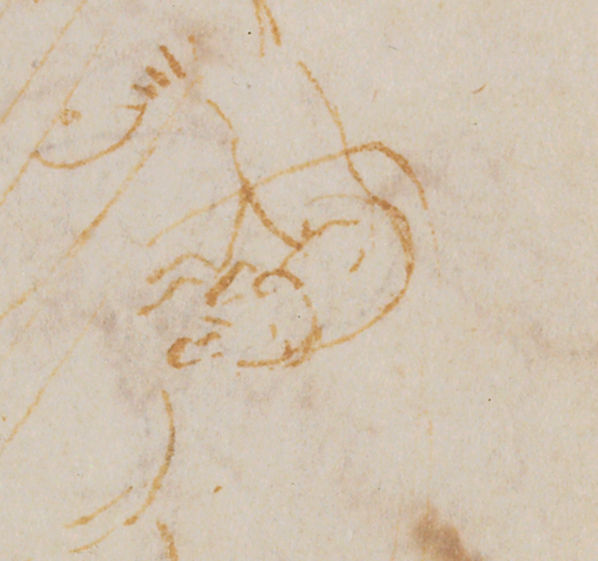
Wallraf-Richartz-Museum & Fondation Corboud, WRM, Z 02003, Leonardo da Vinci, Feder in Braun über Spuren von Silberstift, 22,2 x 18,4 cm
Above, Fig. 14: Leonardo, Study of figures for The Adoration of the Magi, detail of scribbled hand, Köln, Wallraf-Richartz Museum (see Fig. 13).
A last example of the usefulness for an art historian to be familiar with art practice seems necessary here although it is one about a cleaning tragedy. When the world-wide restoration controversy concerning the cleaned Michelangelo ceiling in the Sistine Chapel started in the late 1980s, I had doubts about the full pertinence of James Beck’s position: his objection was that the retrieved fresh and acid hues underlying the dirt and the glues laid in the course of time over the masterpiece’s surface were not what Buonarroti had wanted, and so, that he had toned them down and modelled the forms’ volume a secco with added layers of black bound in animal glue (Fig. 15A and B). Whether this was the case or not, the rather brownish and dark aspect of the frescoes before the intervention, which I had first seen as it stood in 1966, could be accepted as a likely hypothesis. Nevertheless, Michelangelo’s vivid palette’s range of colours was a well-known one, firstly because the Tondo Doni (Florence, Uffizi), cleaned c. 1993 – and so, gently – shows colours in full accordance with the Sistine Chapel ceiling, secondly, because, to some extent, they are close also to those of Domenico Ghirlandaio, Michelangelo’s master, a fact notably testified by Domenico’s fresco cycles in the Palazzo Vecchio (Sala dei Gigli) and in Santa Maria Novella (Tornabuoni Chapel) in Florence [Fig. 16 A and B]. Given that the debate was far too hot and complex I long stood off it, while strongly doubting the pro-cleaning camp’s theory whereby Michelangelo would never have made any a secco adjustments in the ceiling. For many reasons, that was indeed a bold and questionable argument in the light of art practice: no artist, even such an outstanding genius fresco painter like Michelangelo, could ever manage to cover a surface of 1200 square metres – the approximate size of the Sistine Chapel ceiling – with paintings without having to adjust part of his work here and there a posteriori. It definitely is an inconceivable material and human achievement and the impossibility of carrying out such a mythical feat is alone, of necessity, the strongest argument in favour of James Beck’s and Michael Daley’s position. Since the publication of both authors’ book, Art Restoration – The Culture, the Business and the Scandal, in 1993 and in 1996, and Prof. Beck’s death in 2007, Daley has step by step further developed his original reflections on the issue (as first published in The Independent on Sunday – “Michelangelo: Found or Lost?” – 25 March 1990, and the Independent – “A crime against the artist” – 22 November 1991), using visual demonstrations that leave no doubt about the unfortunate suppression of Michelangelo’s a secco retouching, whether it be, here, cast shadows, elsewhere, strengthening in the volumetric modelling of the biblical figure’s monumental anatomies and draperies (- see “Misreading visual evidence – No 2: Michelangelo’s Sistine Chapel Ceiling”). The fact that the restoration team “discovered” later on that Michelangelo has practiced a secco painting in the Last Judgement, and strangely not in the ceiling, although the same buon fresco technique and process was followed, makes it an open and shut case of the entire cleaning project’s technical misconception and miscarriage. [16]
Above, Fig. 15: A (left), Michelangelo, The Sistine Chapel ceiling before cleaning; B (right), Michelangelo, The Sistine Chapel ceiling after cleaning.
Above, Fig. 16: A (top), Michelangelo, The Holy Family (The Tondo Doni), c. 1504, Florence, Galleria degli Uffizi; B (above), Domenico Ghirlandaio, The Marriage of the Virgin, 1486, Florence, Santa Maria Novella, Cappella Maggiore.
Above, Fig. 17: A (top left), Michelangelo, detail of Jonah on the Sistine Chapel ceiling (before cleaning), B (top right), Michelangelo, detail of Jonah on the Sistine Chapel ceiling (after cleaning). The cast shadow of the Prophet’s left foot has been practically cleaned off during the restoration. The putti in trompe- l’oeil sculpture supporting the fictitious cornice have also lost much modeling and volume through that regrettable intervention. C (above), Giorgio Giulio Clovio (1498-1578), Copy of Michelangelo’s Prophet Jonah in the Sistine Chapel, Rugby Museum of Art, Rugby, England. This contemporary drawn record of Michelangelos frescoes, proves that the cast shadow attached to Jonah’s left foot had indeed been present from the beginning. It was also recorded in the subsequent copies of the Jonah that were made from the 16th century onwards [see The Sistine Chapel Restorations, Part III: Cutting Michelangelo Down to Size.
V – The still missing artistic-technical critical edition of Leonardo’s Trattato della Pittura
Leonardo had intended c. 1490 to write a treatise on painting which he sketched out in the Manuscript A kept in the Institut de France. This enormous book of various texts and themes of research, illustrated with original drawings, was never published in his lifetime, but his pupil and assistant Francesco Melzi (c.1491- c.1570), who had inherited all the master’s manuscripts and drawings in 1519, compiled the material c. 1530 from eighteen of the manuscripts in order to prepare the publication of Leonardo’s Trattato. This did not occur in Melzi’s lifetime either but the earliest compilation in existence, the Codex Vaticanus Urbinas Lat. 1270, also called the “Codex Urbinas” or “Libro di Pittura”, is kept in the Biblioteca Vaticana in Rome since c. 1640 [Fig. 18]. Its full text was first published in Rome by Guglielmo Manzani in 1817 while the first critical edition was published by Heinrich Ludwig in Vienna in 1882. Since then, many critical and facsimile editions have been issued, one still recent being the joint work of Carlo Pedretti and Carlo Vecce (Florence, 1995). As is the case for such specialized editions, the authors have focussed on the restitution of the full text through an effort of strict paleographic/ philological/ lexical accuracy, with the necessary reference to Leonardo’s original manuscripts from which these texts were compiled, and to critical editions such as Ludwig, 1882, the facsimile McMahon edition with English translation (1956), or Pedretti’ s “Leonardo’s Lost Book (Libro A)” of 1964 [17]. When I started consulting the Codex Urbinas for my research systematically, I soon realized that another type of critical apparatus was missing, the more so as the book is a treatise on painting, that of a technical commentary of all the specific matters dealt with by Leonardo in the Trattato. I do not mean just literary, theoretical and contextualized views on those matters but ones enriched with pragmatic observations tested out in practice and checked by experimented art teachers, chemists, opticians, etc. of our day. This was no unrealistic expectation on my part: not to speak of Pedretti’s critical comment of Leonardo’s sheets of Anatomy published jointly with a physician, Dr Kenneth Keele in 1978-1980, such a type of edition exists for Cennino Cennini’s Il libro dell’arte, more precisely the Neri Pozza one (Vicenza, 1971 and 1982), which is annotated by Franco Brunello, a chemist specialized in pigments and dyes [18].
Above, Fig. 18: The Codex Urbinas lat. 1270, Rome, Biblioteca apostolica vaticana.
The necessity for this technical edition of Leonardo’s Trattato had appeared to me when I came across a well-known – yet supposedly enigmatic – case of perspective analysed by Leonardo that has been debated over many years, roughly since 1927 up to 1978 and later, with the involvement of such specialists as Irwin Panofsky, Irma. A. Richter, John White, André Chastel, Carlo Pedretti and James S. Ackerman, in particular. The case in question implies the distance of the artist’s viewpoint from the represented object, a problem that the painter must settle with care because linear perspective generates lateral distortions (should the object’s shape be a long horizontal one, for instance) when the viewpoint is too close and exceeds a visual angle of 90°. [Fig. 19] As demonstrated by both Pedretti (1963) and Ackerman (1978), Leonardo was aware of it, specifies which viewing position is the ideal one, and, consequently, has never invented a mysterious – and convenient system (“curvilinear” perspective is evoked in the debate) – specially intended for solving the case. Yet the long lasting disputa over the issue could have been avoided thanks to some basic investigation into the drawing-from-life techniques still taught in fine art schools when the debate took place: like Leonardo before them, and so from a multi-secular tradition, all the art teachers of the period knew the rule to be respected in this connection.
Above, Fig. 19: [After Didier Bessot “Léonard de Vinci et les distorsions perspectives”, Léonard de Vinci entre France et Italie ‘miroir profond et sombre’, Caen, 1999, p. 37-54, Fig. 1, p. 41]. Piero della Francesca, De prospectiva pingendi, libro 1, proposition XXX. The problem of the viewing angle (LM > L- 21 = LK and LM, image of KL > 21-F, image of 21 – B) dealt with by Piero : in order to avoid lateral distorsions, the viewing angle in a perspective construction should not exceed 90°.
Another drawback, so to speak, is the fact that the various technical topics contained in the critical editions of Leonardo’s Trattato are thought to be utterly comprehensive, their artistic sense and function included, whereas what is clarified in this particular field is at best of literary order (etymological, etc.) and not their factual role within a given creative process, thus allowing a shift in meaning that will necessarily distort the historical veracity of the literary source and the correct understanding of the evoked techniques. That is the case with sfumato, meaning “smoky” or “misty” – more precisely a vaporous looking pictorial effect having no distinct boundaries. It is a nominalized past participle of the Italian verb sfumare (to smoke) which studio vocabulary has made become a noun through the centuries; sfumato is now commonly used to describe, not only Leonardo’s soft-focus effects as observed in the Mona Lisa and his late paintings, but the relating technique also. In my essay of 2014 about technical practice in Leonardo’s workshop, I have signalled that sfumare, utilized many times by Leonardo to describe this otherwise ageless technique (that of blending the tones to achieve impalpable, blurred, gradations between light and shade), was employed already in the late 14th century Italy, by Cennino Cennini [19]. Picking up the concerned passage in my above-mentioned peer checked essay, yet with no mention of my name although I had sent him a copy of the academic review in which it was published, Martin Kemp now attempts to demonstrate that sfumato is not a suitable term, historically, to evoke the various concepts underlying Leonardo’s blurred effects and the relating technique of execution [20]. I naturally disagree, because what prevails in such a case is usage – and particularly so when a very ancient one. In old master tradition and workshops the terms used referred to precise artistic-technical data (here a painting process), whose specific meaning is grasped correctly by artists alone, like a musical code or of any other sort, for it is a specialized lexis. Searching a ready-made academic sense within traditional workshop usages and terminology – as if for some catch-all mathematical formula – is therefore pointless and a mix of genres. In this arena, unspecialized parties, inevitably, cannot but misinterpret the highly technical data inherent of studio practice recorded in ancient literature, which, naturally, need instead the methodical examination/interpretation and eventual testing out in practice by truly experimented practitioners – which Kemp is not – to be explained properly (hence the scholar’s missing crucial information borne in the texts quoted either in his own essay on sfumato, or from Leonardo on technique, as we shall see below). Whatever the case, given its long existence, the ancient usage of sfumare and of its derived terms (including sfumato) in art is nothing to be rejected: we can well see that that verb’s technical sense, a generic one when it applies to the art of painting, is the same when it is used by Cennini, by Leonardo and by Filippo Baldinucci (c. 1624-1696) indifferently over a period of four centuries. And since Leonardo, writing about technique in the Trattato della Pittura, describes a method of melting the tones to make them look smoky, one can hardly imagine that the words employed do not mean both the rendered effect and its technical process, as is evident in this eloquent – and most famous – passage of the Codex Urbinas (Pedretti/Vecce edition, op. cit. supra note 17, § 514): “and when the flesh paint is wet, [using soft brushes] you will make the shadow smoky as you please (…) When your sfumato is made, let it dry” [21].
This well-known text clearly shows that we are faced here with a sfumato process which I call “the simple blending of tones” or “the simple fusion of colours” [22]. In effect, Melzi’s transcript of Leonardo’s recipe informs that the paint material to be made look fumoso (misty, blurred, etc.) is “wet” and that it is handled with “soft brushes”. It is precisely the state in which the paint material should be so that such a process can be performed while a soft brush will allow its adequate achievement. Called blaireautage in French, it is, as we now know, an ageless technique in which the paint film is gently “blended in” in the sections to be unified visually, in particular where the impalpable transitions between light and shade must be depicted [23]. The simple blending, however, is not by far Leonardo’s most subtle sfumato technique, because the specific technical gestures involved cannot produce microscopic transitions on very short distances, measurable in tenths of millimeters, like those seen in the Mona Lisa, for example [24]. In that particular case, the soft brushes used for the blaireautage (simple blending of tones) are far too large and inadequately shaped: painters necessarily employ brushes and paint strokes whose dimensions and shapes conform to the scale of the details to be reproduced. Consequently, the technical problem examined here is a clear-cut one: while soft, rather large and flat brushes are used to achieve the blaireautage (type 1 sfumato effect), very fine brushes with a sharp tip alone are required to achieve the “complex blending” (type 2 sfumato effect). In other words, neither of those distinctly sized and shaped brushes can replace the one meant for its specific technical purpose, whether it be for the sfumato effects type 1 or type 2. One can now understand why art historians strange to practice, unless properly informed, should not speculate on painting techniques as complex as that of Leonardo, given their deep ignorance of how artistic craftsmanship functions in the real. Except specialized artists, not many people can discern visually the important difference of refinement, hence of technique, regarding those micro-distances when examining the Leonardo works, notably the Mona Lisa, in which either type of sfumato process was followed: to some eyes, obviously untrained, all blurred effects seem to correspond to one and a same one, apparently.
Above, Fig. 20: Leonardo, The Lady with an Ermine, c. 1489- 1490, Cracow, National Museum.
Leonardo has practiced the simple blending in works like the Lady with an Ermine (Fig. 20) or the London Virgin of the Rocks, a process that X-radiographs reveal distinctly due to the amount of lead white (an X-ray proof pigment located very distinctly on them) needed for the lights in this technique (see Further Thoughts I, Fig. 27a and b). Despite this telling example, Kemp insists: “we should be aware that the term [sfumato] is an artefact of art history not a quotation from Leonardo [25]. Furthermore, quoting Baldinucci’s Vocabolario (1681) to make his point, he seemingly is unaware of the fact that this author contradicts it. In effect, Baldinucci’s text describes the standard sfumato technique, or blaireautage, used in his time, not the very complex and spectacular one handled by Leonardo in the Mona Lisa and the Sainte Anne (see Further Thoughts II), which, as we know, is an entirely different one in terms of making process. The 17th century Florentine biographer of artists actually says: “[sfumare, To unify colours] (…) after having put the colour in its place on the canvas or panel, in order to remove all crudeness of the touches, sweetly mingling the light tint with the middle tint or the middle tint with the dark, so that the passage from one to the other is made with such gradation that even from close the painting appears without brushstrokes” [26]. The choice of Baldinucci’s text is therefore of little pertinence here with regard to that of Leonardo’s extant ones on technique, or compiled by Melzi: it was published in the late 17th century, 162 years after Leonardo’s death and does not describe his technique as such in the least way, but, rather, the generic artistic gesture of sfumare as executed then (thus implying slight variations from the early 16th century practice of that technique) in order to unify visually the raw effect first obtained in the execution, and to smooth down the paint surface at the same time. Although Kemp asserts authoritatively that “Baldinucci sets the right tone” [27], his credibility is nonetheless at risk when hypothesizing without any evidence or reliable experience of practice that it was the technique used in the Mona Lisa. For Baldinucci’s description also informs that fresh paint is handled, which necessarily implies the practice of blaireautage or “simple blending”, in which the fresh paint strokes are mingled and smoothed down in a sort of delicate back and forth sweeping movement done with a soft brush. All of which is far too simple, technically, to explain anything as prodigiously complex as what is seen in the Louvre’s iconic picture: as now proven by X-ray fluorescence and visual observation (see Further Thoughts II), what is typical of Leonardo’s flesh technique in the Mona Lisa (the “complex blending of tones”) is that it needs a dry underpaint and not a wet one to be proceeded with: it is therefore, basically, a dual operation and not a single one. The visual abolition of the touches (hatches, strokes, etc.) is far more gradual in the complex blending: thin veils of liquid translucent paint are laid over each painting session when it is dry until the paint surface appears perfectly smooth and even. About twenty of such veils have been detected in the Mona Lisa thanks to X-ray fluorescence tests, thus revealing an extremely elaborate and subtle making that justifies my description of two distinct procedures in Leonardo’s sfumato technique (see Further Thoughts II). While the term sfumare is fully appropriate to the first one, the second one’s complexity results from the systematic superimposition of veils (whose nature and typology vary greatly): velare (to veil or glaze/soften the rawness of tones in Italian) has therefore all the reasons to be employed in that case instead of sfumare. A century before Baldinucci, or nearly so, it is presumably why Giovanni Paolo Lomazzo (1538-1592), who had met Francesco Melzi (Leonardo’s closest pupil) and gathered then precious information about Leonardo, described in 1590 the master’s sfumato technique as “veli sopra veli” (superimposed veils), a better designation than sfumare with regard to the overall line of making observed in the Mona Lisa [28]. Additionally, the complex blending observed in the Mona Lisa corresponds without contest to Vasari’s report on the portrait (who never saw it but its description was obviously borrowed from Melzi): “Leonardo undertook to execute, for Francesco del Giocondo, the portrait of Monna Lisa, his wife, and after toiling over it for four years, he left it unfinished (…) in it were counterfeited all the minutenesses that with subtlety are able to be painted” [29]. Should Leonardo have employed the blaireautage process, an easy and quick one, the end result would be far less subtle and, for that reason, the work would have been finished within four to six months at the very most: applied to the Mona Lisa, that technical interpretation has therefore, I am afraid, no historical likelihood.
Reverting to the arbitration of practice, which is the best means for checking the pertinence of theories in matter of painting techniques, the reader must know that no copy resembling the Mona Lisa very closely (which would be evidence of the appropriateness of the technique used), could ever be produced employing Baldinucci’s recipe, and, knowing the subject extremely well from decades of experimentation, I defy any skilled artist to perform such a challenge [30]. Finally, the fact that Leonardo’s sfumato lies on optical concepts more particularly than that of other artists is no evidence of the term’s historical inaccuracy with regard to the Master’s blurred effects and correlated technique. And unless the texts compiled in the Codex Urbinas were proven in future not to come from Leonardo – a very unlikely eventuality – it can reasonably be admitted that sfumato was indeed a term used by him and his studio, whether occasionally or not.
VI – Interdisciplinary work: a salutary concept
Given the transverse (multidisciplinary) character of old master expertise, nobody would expect that one and a same specialist be simultaneously familiar with archival research, well versed in academic art practice, in restoration techniques, and that the physics and chemistry of paints hold no secrets for him. Yet, the entire knowledge contained in those distinct disciplines is necessary to approach adequately the works’ full facets, whether historical, artistic or material. As explained in the first chapter of this essay, specialized artists, unless they are conservators, have no recognition as art experts, and, although it is unjustified, since illogical, aesthetic-technical matters are assessed nowadays by parties (art historians and scientists) who are no specific experts in this field. In the past, about eighty years ago, conservators were most of the time academic artists who could not make a living out of their activity and had taken up restoration to secure themselves an income. This was notably the case with Jean-Gabriel Goulinat (1883-1972), seriously trained in the Paris national Ecole des Beaux-Arts, and Jacques Maroger (1884-1962), who made careers in 1930-1960 at the Louvre (Maroger in part only): it was a blessed period during which, the then head curator of Paintings, René Huyghe (1906-1997), had, jointly with Cesare Brandi (1906-1988) – the world reputed Italian theorist of conservation – defined a highly tactful conservation policy for the restoration of France’s and Italy’s old master heritage [31]. At that time, the restorers were fully trained artists who were able to advise on the Louvre’s restoration committees and, eventually, point out to aesthetic-technical data that would contribute decisively towards the successful outcome of conservation projects. Significantly, the Louvre Leonardos had hardly been touched up, with the exception in the late forties-early fifties of the Sainte Anne, whose conservation report is very telling on the discreet cleanings undertaken in those days. Progressively, this way of proceeding was thought outdated and, worse, by the late seventies, in university and museum circles in France and elsewhere, it came to be considered that artistic advice on restorations was subjective, inadequate, and that scientific analysis and art historians alone could determine safely where the authenticity of paintings lies. In these times the work of art ceased to be the pre-eminent, intrinsic per se source of information on significant artistic and technical data about itself, in the way that musical scores were – and still are – regarded by musicians. Thus works of art became objects of unclear identity and quite divorced from the traditional artistic criteria that had remained in force from the Renaissance until our own times. In consequence, anarchic views prevail to date on the authentication and destiny of works of art.
In 1983, I was hired by a private conservation institute in Paris (Institut d’Art Conservation et Couleur) which was run by both the then leading Louvre conservator Sylvaine Brans and Prof. François Parra, an international State authority on Optics and the physics of colour [32]: the institute was training student restorers and my role was to instruct them on old master techniques because, while their technical capacity to preserve and repair paintings materially was satisfactory, practically none of them had ever learnt to draw and paint and, therefore, knew much, to say the least, about the aesthetic-technical side of art. In 1986, I pursued a similar teaching job to student restorers for fifteen years within another professional framework: many of them intended to access international schools of restoration (IRPA in Brussels, IFROA in Paris, ICR in Rome, etc.). From this experience I am ipso facto closely acquainted with the ins and outs of painting conservation (artistic aspects) and, more specially, with the fact that – bar exceptional cases – the majority of today’s restorers cannot face the complexities inherent of this discipline where properly speaking artistic matters bringing up any difficulty are concerned. Although I ignore whether it was and has been the case with leading museums in the world at all times, the Louvre was certainly aware of this problem in the mid-eighties when my research first got some marked support from René Huyghe, then still chairing the Museum’s national committee for restoration and from Alain Erlande-Brandenbourg, the then main assistant to the Head of the French museums (DMF).The team in charge of the Louvre’s conservation studio was a brilliant one in those years, notably under the heading of Gilberte Emile-Mâle and that of her successor, Curator Ségolène Bergeon, a disciple of Prof. Paul Philippot (1925-2016), who, himself, was a reputed theorist of conservation, a university professor in Brussels and the head of the Rome ICCROM. Both an art historian, a scientist and an IIC Fellow, Bergeon had long understood that painting restoration is a transverse discipline calling for a combined, qualified and joint expertise drawn from art history and academic artistry applied to conservation, and, of course, science, the ideal objective hereupon being to limit as much as possible the subjectivity of such an action in order to better preserve the work’s material and spiritual integrity. Hence Bergeon’s early commitment in favour of interdisciplinary (or crossdisciplinarity) work in conservation, an early 19th century concept revived by both Brandi and Philippot – and later theorized by Madeleine Grawitz definitively – [33], advocating that the “threefold” expertise (history + art + science) needed to restore a work of art be practiced as a constant and mutual collaboration between the different professional parties dealing with the work’s conservation treatment. And this, unlike pluridisciplinarity, in which the concerned experts advise the restoration project separately, thus risking eventual conflicts between each individual position, no profitable dialogue over the problems raised in the course of the intervention and, as a consequence, that less or no attention is given to what the work really needs [34] (Fig. 21). Such a practice as interdisciplinary collaboration is demanding in terms of self-discipline, for it implies a humble attitude and the eventual renunciation to one’s feeling of professional superiority towards a given essential partner in the team as well as a sincere open-minded disposition to exchange with others for the sake of the work’s preservation. Unfortunately, such a disinterested and humanistic conception of a group’s working program is far from being an ideal shared in the museum world broadly. I once attended a Bergeon lecture on interdisciplinary work in 2003 at the Association des Historiens de l’Art Italien (AHAI) in Paris and was sitting next to a specialist of scientific imaging in the Louvre’s laboratory (C2RMF), an otherwise urbane and pleasant person who has left this institution long ago. When Bergeon’s intervention ended, Mr. X whispered in my ear this irritated comment: “For sure it’s not a line we shall ever bother to follow in our lab!”
Above, Fig. 21: [After Ségolène Bergeon Langle and Georges Brunel, La restauration des oeuvres d’art, Vadem-mecum en quelques mots, Paris, p. 205, Interdisciplinarity and pluridisciplinarity].
Diagrams showing each discipline with a specific colour (1 blue = physics, 2 yellow = artistic/technical-craft, 3 red = human sciences). In the case of interdisciplinarity (in the context of a conservation project), the three disciplines are in constant mutual dialogue and the end result is a fully informed product. In the case of pluridisciplinarity, the juxtaposition of partial actions from distinct specialists (physics, artistic/technical-craft, human sciences) does not deliver a unique and fully integrated product.
VII – By way of conclusion
Although what precedes remains schematic and incomplete, it is obvious that the artist’s place and of everything that is intrinsic to the artistic, creative phenomenon, is not at the heart of art expertise and conservation any longer, a situation which has been lasting for several decades now to the point of having become a de facto tradition. The causes of this are many: one of them is the decline, if not outright abandonment, of teaching the multi-secular academic rules of drawing and painting in the European fine art schools as from the sixties onwards; another being the nonsensical, demagogic belief that has developed in parallel worldwide under the influence of the various trends of modern and contemporary art whereby anybody can be an artist – an idea open to discussion, perhaps, with regard to today’s creative concepts, but one which cannot sensibly be backdated so as to apply to classic art, whether historically, conceptually or technically. Such a global cultural development has necessarily lowered art’s spiritual level down to criteria that oppose its fundamental identity which cannot be dissociated from its traditional, long-prevalent art practices in an attempt to convert it into what it is not and has never been. In such a confused cultural context, the situation has, in the mind of some scholars, so evolved in the last twenty years as to dissolve any distinction between art history as a discipline, which is a branch of history, nothing else, and art practice itself. A number of art critics occasionally seem to believe (see Further Thoughts II ), that their own self-contained (i. e. divorced from artistic practice) visual appraisals of a painting visually are sufficient to understand it thoroughly – including the various processes of its making – as if they themselves had painted it. I have come across a number of such cases in the museum world recently, in three of whom the self-delusion, if not pathological, had reached such a paroxysm that no evidence of any sort, either visual or scientific, proving the inconsistency of their position, could bring them back to reality. They just could not accept it. The origin of this alarming emerging syndrome of “virtual” or “imaginary scholar-painters” lies in the dogmatic conviction that a given qualification in art history sanctioned by some power, either scholarly or curatorial, confers both infallibility and an automatic access to the full knowledge of art and to what its creative methods consist in. There is here an abusive appropriation of the authority traditionally and rightfully conferred to artists through their demonstrable mastery of the creative process, a field strange to both art history and science. In other words, to some extent and more than symbolically, art is not in the hands of art any more but in those of institutional parties having no direct experience of it, who cannot but transliterate it in a language of their own presented as the truth, whether rightfully or not according to circumstances (see § V above).
Sense and reason help to grasp the point in case clearly: the best way to know anything sound and factual about art is to draw, paint or sculpt. And the best way to penetrate into the aesthetic-technical creative intimacy of an old master painting is to make a faithful copy of it, and eventually one whose appearance is practically analogous to that of the original. In so doing it is possible that the making process will not be the very one followed by the creator himself, whether it be Rembrandt or Rubens, etc., but it might well be the case indeed, as I have succeeded to prove with Leonardo’s sfumato technique through decades of painstaking research and thanks to critical copy-work in particular (see Further Thoughts II). In addition, when a copy resembles the original closely, the copyist has at least demonstrated his (her) direct, tangible – and not imaginary – experience of the essential aesthetic-technical data constituting the original work’s appearance: nobody can in good faith deny that this is a priceless knowledge, a reality that no virtually informed speculation on technique will ever match or challenge. Because what decides between opinions here, i. e., one strictly conceptual and immaterial, and another one tangibly visual and material, is, in the latter case, evidence of art as opposed to theoretical verbiage about it [35].
Above, Fig. 22: A, left and right – Jacques Franck, critical reconstruction in four stages of the Mona Lisa’s left proper eye; B – Jacques Franck, free copy in oils after the St. Anne in the Burlington House Cartoon (London, National Gallery).
This very point explains why my research on Leonardo’s painting technique has been so reluctantly accepted, if at all, in those circles: notwithstanding the providential support from specialists of an unsurpassed competence such as René Huyghe, Carlo Pedretti, Federico Zeri, Ségolène Bergeon Langle or Jacques Roire (physicist and chemist), the issue of Leonardo, effectively, is considered their exclusive property, so to speak, and therefore one “forbidden” to an independent scholar’s artistic research like mine, regardless of the deployed skills and of the related visual demonstrations of scientifically proven pertinence (Fig. 22 A and B). By the same token are explained also the attacks that have suddenly flourished in my back from the very moment I opposed the attribution of questionable graphic compositions to Leonardo and the serial restorations of the Louvre Leonardos and, in particular, campaigned against the participation of the originally New York, then Russian, now Saudi Salvator Mundi in the Louvre Museum’s 2019 blockbuster exhibition as an authentic da Vinci painting [36] (Figs. 23 and 24).
To sum up, the Establishment’s disregarding of and opposition to any, properly-speaking, artistic and pragmatic means of research concerning the technical issues requiring elucidation in the art of painting is a clear sign of our society’s weakened understanding and loss of respect of the meaning of art, whether or not it is the remote consequence of Dada, “art brut”, relativist theories, art negativism, the postulate whereby anybody is a potential artist or, worse, of the sophist claim that “science can explain art”. Assessing the innumerable PhDs produced by the history of art scholarship each year, one can easily notice that, more often than not, it is becoming a strictly speaking literary activity in which the art work serves to support questionable theories, intellectual elaborations substituting their virtual reality for its own, factual one. Statistically, little archival research is made, which explains why so few documents about Leonardo have emerged in the past century. Concerning Leonardo studies, beside the “classics” (including Frank Zöllner’s catalogue raisonné), what remains and catches attention are of course the comprehensive publications on different topics from scholars like Carmen Bambach, Alessandro Ballarin, Carlo Vecce, Edoardo Villata, or more specialized ones, notably in matter of Leonardian bibliography (I cannot but mention the brilliant Silvia Fabrizio-Costa in this respect) [37], which are references constantly used for working on a subject like technique, an issue needing solid historical documentation. Yet, in some of those works, when the pictorial techniques are evoked, the painter’s viewpoint is skimmed over, while nobody, to my knowledge, manages to achieve any appropriate art critical distance from the end results of restorations like that of the disappointing Last Supper in Milan, for example. [38] (Figs. 25, 26 A, 26 B and 27). Naturally, given the hot nature of the polemics over questionable restorations, were they brought back to serene, scholarly debates and exchanges, these projects being mostly under State control, no museum curator or university official – or very seldom – will accept to speak out in the open to express objections. But then, who will want to save and rescue the Art Planet, if these powerful VIPs won’t point out to what they know should be contested in order to help salvage the world’s Heritage?
Many years ago James Beck and Michael Daley, in Art Restoration – The Culture, the Business and the Scandal (1993, 1996), denounced the progressive disintegration of the ethical standards and morals in the art world whereby the artistic treasures of the universal Heritage are commercially exploited against their basic spiritual and physical interests through vicious cycles of money making exhibitions and/or needlessly risky restoration projects that have become a self-perpetuating world-wide industry. Such attacks on the most essential icons of our civilization’s very soul run in strict parallel with and proceed from the same logic of the frames of mind that cause the attacks on Environment which, inexorably, are destroying the planet. More recently, Ben Lewis’s book The Last Leonardo, and two documentary films about the shattering saga of the Saudi Salvator Mundi have sadly proven that Beck’s and Daley’s voices of 1993 have been little heeded. Arguably, the toxicity of the art world has worsened in the last twenty years as an escalating abundance of unjustifiably upgraded works, whether paintings, drawings or sculptures, are presented as lost or misattributed Botticellis, Raphaels, Leonardos or Michelangelos, etc. when, in truth they are at best studio works or late school items – and sometimes outright fakes, as was the case with a notoriously freshly imitated “Frans Hals” lately [39]. The curatorial obsessions of museums regarding the “cleanness” of the privately loaned works exhibited in the international shows provoke severe – yet too rare – admonitions from museum figures who have retained an inflexible sense of ethics. In the documentary The Lost Leonardo, reporting on the London National Gallery’s role in the tangled story of how the (New York to Saudi) Salvator Mundi emerged from obscurity before being sold for $450m, Professor Bernd Lindmann, the then director of the Gemäldegalerie in Berlin, tells Andreas Koefoed (the co-film maker): “I was surprised to see the painting in the [2011 Leonardo] exhibition at the National Gallery. It is a problematic painting and I think it’s not the role of serious museums to present a painting which is so heavily discussed”.
Above, Fig. 23: [After Achademia Leonardi Vinci, Vol. X, 1997, p. 269]. Nomination of Jacques Franck as Consulting expert to the Armand Hammer Center for Leonardo Studies at UCLA by Carlo Pedretti (see note 36 below ).
Above, Fig. 24: Email from Carlo Pedretti of 16 January 2016 expressing his will that Jacques Franck be Permanent consultant of his newly established Foundation. A printed version of which (here) was confirmed again by Pedretti’s signed and annotated approval of 27 November 2017, six weeks before the great Leonardo scholar’s decease on 5 January 2018 (see note 36 below).
Above, Fig. 25: Leonardo, The Last Supper, 1497, Milan, Santa Maria delle Grazie.
Above, Fig. 26 A: Leonardo, The Last Supper, detail of St. Philip. All that remains of the original work are small scales of colour appearing the more saturated ones on this image of St. Philip – which is possibly the best preserved figure in the mural. Surrounding the surviving shards of paint, whether red, flesh pink, blue, brown, or black, the paler tones constitute the considerable retouching (called “inpainting”and compensating for the lacunae), that was necessary to make the composition both visually consistent and fit to be seen by the public of visitors. The missing original paint can therefore be assessed around 60 to 80% in Leonardo’s Last Supper.
Above, Fig. 26B: Leonardo, The Last Supper, detail of St. Philip. This close-up on the apostle’s head shows distinctly the huge areas where the original paint is missing. Compare with Fig. 27 below.
Above, Fig. 27: Giovanni Pietro Rizzoli, called Giampietrino, copy of The Last Supper, c. 1520, The Royal Academy of Arts, London.
It is in this context of the Art Planet, clouded by the constant emergence of disputable, opaque, interests, that I publish my recent investigation of the “no book” titled Léonard de Vinci. Le Salvator Mundi, published by the Louvre in December 2019, while withdrawn immediately from the Museum’s bookshop without any explanation, but of which photocopies have circulated in the Leonardo scholarly “microcosm” and in the international press earlier this year. An essay presenting the Saudi Salvator Mundi as a work fully painted by Leonardo based on scientific arguments which, in my opinion, are anything but acceptable; I therefore have thought it my duty for the truth’s sake to discuss them in-depth and openly below, so that the reader can understand why the French government has considered it essential not to publish them and, as a consequence, not to support the work’s attribution to Leonardo either.
Jacques Franck, November 2021.
ENDNOTES:
Note 1: Cf. Jacques Franck, “De la formation artistique en conservation-restauration des peintures anciennes: évoluer, pourquoi, comment”, Coré, n° 4, avril 1998, p. 53-59.
Note 2: Cf. Léonard de Vinci, le chef-d’œuvre redécouvert, documentary movie broadcast on the French/German TV channel Arte on 13 November 2019. The title of this movie is interesting inasmuch as the rediscovered “chef-d’œuvre” in question (“masterpiece” in English) is in fact the American version of The Madonna of the yarnwinder of c. 1501-1510 (New York, private collection), a well-known Leonardesque painting, here ambiguously upgraded as by Leonardo himself following its recent cleaning, yet still deserving the traditional attribution to a Milanese pupil since it doesn’t comply with the artistic standards usually encountered in original Leonardos.
Note 3: Stricto sensu glazes are perfectly transparent layers of tinted paint, mostly used to brighten or deepen the tone of the underlying layer or to modify it: a bright transparent blue glaze laid over a yellow underlayer will thus create a green visually. Given that the flesh tones cover a range of pale, opalescent pinks, some white and added touches of relatively opaque pigments must be employed instead of transparent ones – while much diluted – in the meticulous oil techniques encountered in the late 15th century Italian schools, the result of which is a translucent, thin veil-like paint film, hence the term of velatura (veil) in Italian. For the physics of glazes, see Ségolène Bergeon and Pierre Curie, Peinture & dessin, vocabulaire typologique et technique, 2 vols., Paris, 2009, vol. 2, p. 738.
Note 4: Cf., successively, my following articles addressing this particular issue: “The Unrestorable Sfumato“, Achademia Leonardi Vinci, vol. VI, 1993, p. 238-241; “L’analyse esthético-technique des peintures de chevalet anciennes”, Science et Technologie de la Conservation et de la restauration des oeuvres d’art et du patrimoine, n° 3, septembre 1993, p. 5-50, p. 33-41; “Vinci au Louvre. Restauration de la Sainte Anne: suspension du chantier”, Double Liaison, physique, chimie et économie des peintures et adhésifs, t. XLII, n° 467-468, 1995, p. 29-33; “The Mona Lisa: Should a Myth be Restored?”, Achademia Leonardi Vinci, vol. VIII, 1995, p. 232-236; “Pourquoi il ne faut pas restaurer La Joconde“, L’Estampille-L’Objet d’art, n° 328, octobre 1998, p. 26-33; “Why the Mona Lisa Might Not Survive Modern Day Conservation Treatment”, The Proceedings of the Art, Law and Crises of Connoisseurship Conference, held at the Society of Antiquaries of London, 1 December, 2015, ArtWatch UK Journal, n° 31, 2017, p. 18-31 (hereafter ArtWatch Conference, 2015).
Note 5: This is notably the case in the Louvre’s Virgin and Child with Saint Anne (the Saint Anne), in which St. Anne’s face, displaying subtle transitions between light and shade comparing the impalpable effects in the Mona Lisa, betrays the presence of Leonardo’s “complex blending”, thus explaining the very thin, flat and translucent paint layer in that section where very poor quantities of lead white were used (unless in very small quantity, the latter pigment is inappropriate to this type of technique). Conversely, the Child’s face contains lead white in the lights substantially, and so in accordance with the far less complex, traditional blending of tones (see below chapter V, the passage about Leonardo’s sfumato technique).
Note 6: Cf. respectively, Léonard de Vinci, Paris, musée du Louvre, 24 October 2019 – 24 February 2020, catalogue by Vincent Delieuvin and Louis Frank (hereafter Paris, 2019-2020); Jean-Pierre Mohen, Michel Menu, Bruno Mottin et al., Mona Lisa. Inside the painting, English. ed., Paris, 2006 (hereafter Paris, 2006).
Note 7: Cf. Paris, 2006, p. 88-89, figs. 146 and 148.
Note 8: Cf. Paris, 2006, p. 90.
Note 9: Cf. Paris, 2019-2020, p. 368.
Note 10: Cf. Mady Elias and Pascal Cotte, “Multispectral camera and radiative transfer equation used to depict Leonardo’s sfumato in Mona Lisa”, Applied Optics, vol. 47, n° 16, June 2008, p. 1-8. The conclusion of the essay states that “The diffuse reflectance spectra recorded by a multispectral camera after a virtual varnish removal prove that the sfumato of Mona Lisa is made of a single pigment with a small volume concentration, an umber, very common in Italy in the 16th century” (p. 8).
Note 11: Besides the note sent to the authors in June 2008, much dialogue occurred on the subject with Engineer Pascal Cotte when the latter was co-heading the French scientific laboratory Lumière Technology and, more recently, in emails exchanged with him on November 1st and December 1st, 2020.
Note 12: Cf. Michael Daley, “Art’s Toxic Assets and a Crisis of Connoisseurship”, ArtWatch online, 30 September 2014; Michael Daley, “Bertram Nicholls: Doing and Saying”, Jackdaw, March-April 2021, p. 16-19 (p. 18).
Note 13: Cf. Maria Teresa Fiorio, “Leonardo’s Portrait of a Musician and some reflections on his Milanese Workshop”, Leonardo da Vinci’s Technical Practice, Michel Menu editor, Paris, 2015, p. 153-161 (hereafter Menu et al., 2014).
Note 14: Cf. Ségolène Bergeon Langle, “L’appel à la science peut-il décevoir ?”/ “Can Science Deliver Its Promises To Art ?”, ArtWatch Conference, 2015, p. 38-47 (p. 42-43 and p. 46-47).
Note 15: Cf. Jacques Franck, “Léonard de Vinci. De la Sainte Anne de Londres à la Sainte Anne du Louvre: le véritable déroulement d’une création”, ArtItalies, revue de l’Association des Historiens de l’Art Italien, n° 25, 2019, p. 122-138, Introduction by Ségolène Bergeon Langle. Available on https:/www.academia.edu
Note 16: Cf. James Beck with Michael Daley, Art Restoration. The Culture, the Business, and the Scandal, 1st ed., London, 1993, 2nd ed. New York and London, 1996.
Note 17: Cf. Carlo Pedretti and Carlo Vecce, Leonardo da Vinci. Libro di Pittura. Codice Urbinate lat. 1270 nella Biblioteca Apostolica Vaticana, 2 vol., Florence, 1995; Carlo Pedretti, Leonardo da Vinci on Painting. A Lost Book (Libro A) reassembled from the Codex Vaticanus Urbinas 1270 and from the Codex Leicester, Berkeley and Los Angeles, 1964 (hereafter Pedretti and Vecce, 1995).
Note 18: Cf. Franco Brunello: Cennino Cennini, il libro dell’arte, annotato e commentato da Franco Brunello…, Vicenza, Neri Pozza publisher, 1971, reed., 1982.The problem raised here is a crucial one. Many essays dealing with Leonardo on painting (perspective as applied to art, colour theory, etc.) have been published in the course of years, a leading one being John Shearman’s “Leonardo’s colour and chiaroscuro” (Zeitschrift für Kunstgeschichte, 25, 1962, p. 13-47). While of great interest, these researches cannot but stand as strictly theoretical for want of methodical comparison with pragmatic data relating to traditional practice, to the secure interpretation of ancient texts on technique (see below the passage on Leonardo’s sfumato technique in the light of Baldinucci’s Vocabolario and Lomazzo’s Tempio), or to significant scientific – and indisputable – evidence.
Note 19: About sfumato, sfumare, fumosa, fummo ben sfumate, etc., see Jacques Franck, “La pratique du “micro-divisionnisme” dans l’atelier de Léonard de Vinci”, ArtItalies, revue de l’Association des Historiens de l’Art Italien, n° 20, 2014, p. 4-16, Introduction by Ségolène Bergeon Langle, p. 5-6, notes 6-8 included (hereafter Franck, 2014). Available on https:/www.academia.edu
Note 20: Cf. Martin Kemp, “Leonardo and Sfumare. More than Meets the Eye”, Paragone. Leonardo in Comparison, Johannes Gebbhardt/Frank Zöllner (Eds.), Petersberg (Germany), 2021, p. 155 -161(hereafter Kemp, 2021).
Note 21: “[Modo di colorire in tela] e dà l’incarnazioni con penelli di setole, e cosi fresche farai l’ombra sfumata a tuo modo (…) Sfumato che tu hai, lascia seccare”; C. U., fol. 161v, after a lost original c. 1490-1495; my translation.
Note 22: Cf. Jacques Franck, “The invention of ‘sfumato'” in exh. catalogue The Mind of Leonardo. The Universal Genius at work, ed. Paolo Galluzzi, Uffizi Gallery, Florence 2006-2007, p. 338-357 (p. 346 on “the simple fusion of colours”) (hereafter, Franck, 2006-2007); Franck, 2014, p. 6.
Note 23: cf. Franck, 2014, p. 5, note 8 included (blaireautage).
Note 24: cf. Franck, 2006-2007, p. 347 (“the complex fusion of colours”).
Note 25: Cf. Kemp, 2021, p. 161.
Note 26: Cf. Filippo Baldinucci, Vocabolario toscano dell’arte del disegno, nel quale si esplicano i propri termini e voci, non solo della Pittura, Scultura & Architettura; ma ancora di altre Arti a quelle subordinate, e che abbiano per fondamento il Disegno, Florence, 1681, p. 151 (facsimile ed. S.P.E.S., Florence, July 1985). For the English translation of Baldinucci’s full text on sfumare, see Kemp, 2021, p. 160.
Note 27: Cf. Kemp, 2021, p. 159.
Note 28: “Colorare di Lionardo] [dipingeva la forma umana] con una nobil furia di colorito (…) dandogli le ombre, & i lumi variatamente, con veli sopra veli” (“he painted [in the human form] the shades and lights in diverse ways with noble and impetuous colours, placing veils over veils”), my translation. Cf. Giovanni Paolo Lomazzo, Idea del Tempio della Pittura di Gio. Paolo Lomazzo pittore. Nella quale egli discorre dell’origine, e fondamento delle cose contenute nel suo trattato dell’arte della pittura, Milan, 1590, p. 49-50. Strangely enough, in the same essay (Kemp 2021) the author says (p. 160, note 24) that all the necessary analyses of Leonardo’s glazing (hence sfumato) techniques are presented in Leonardo da Vinci’s Technical Practice: Paintings, Drawings and Influence/ La pratique technique de Léonard de Vinci : Peintures, Dessins et Influence, ed. by Michel Menu, Paris, 2014, but despite excellent papers from serious specialists, among whom Elizabeth Walmsley (on the Portrait of Ginevra de’ Benci), Carmen Bambach (on scientific evidence in the study of Leonardo’s drawings), or Alan Donnithorne and Joanna Russel (on the “faded” metal point drawings in the Royal Collection), nowhere is found any such study in that publication.
Note 29: Cf. Giorgio Vasari, Lives of the Most Eminent Painters, Sculptors and Architects, Translated by Gaston Du C. de Vere, Introduction by Kenneth Clark, 3 vol., New York, 1979, vol. 2, p. 789.
Note 30: What precedes reveals the persistent conflict in art history between critical observation and, notably, the questionable belief that, in factual matters like technique, information from ancient treatises or documents can be deciphered effortlessly, theorized thanks to improvised rationales (i. e., strange to studio traditional practices) and then delivered to the academic world as sound, reliable truths without any experimental testing out – thus proving both whimsical and the obvious negation of methodical research.
Note 31: Cf. René Huyghe, “Le nettoyage des peintures”, Museum, vol. 3, 1950; René Huyghe, “le nettoyage et la restauration des peintures anciennes: position du problème”, Alumni, vol. XIX, 1950; René Huyghe, “Le problème du dévernissage des peintures anciennes et le Musée du Louvre”, Musées et Monuments, Unesco, Paris, tome II, 1951; Cesare Brandi, “Il Ristabilimento dell’ unità potenziale dell’ opera dell’ arte”, Bolletino dell ‘Istituto Centrale del Restauro, n° 2, 1950; Cesare Brandi, “Il restauro dell’opera d’arte secondo l’istanzia estetica o dell’ artisticità”, Bolletino dell’ Istituto Centrale di Restauro, 13, 1953; Cesare Brandi, Teoria del restauro, Edizioni di Storia e Letteratura, Rome, 1963.
Note 32: More specifically Prof. Parra specialized in the differential vision of colour.
Note 33: Cf. Madeleine Grawitz, Méthode des sciences sociales, Paris, 1975, 9th ed. 1993, p. 290-293.
Note 34: Cf. Ségolène Bergeon Langle et Georges Brunel, La restauration des oeuvres d’Art. Vade-mecum en quelques mots, Paris, 2014, p. 204-206 (Interdisciplinarité).
Note 35: On the matter of experience prevailing over whimsical theory, see Leonardo’s severe admonition to his contemporaries in the Codex Atlanticus, fol. 327 v (119 v-a), which roughly states that his works are “the issue of pure and simple experience, who is the one true mistress [whose rules] are sufficient to enable you to know the true from the false”, thus blaming “the authority of certain men held in the highest reverence by their inexperienced judgements”. Cf. Jean Paul Richter, The Literary works of Leonardo da Vinci. Compiled & Edited from the Original Manuscripts by Jean Paul Richter, 1st ed. London, 1883, revised ed. Oxford, 1939, paperback ed. New York, 1970, § 12.
Note 36: A noxious rumour circulated from 2012 onwards concerning my title and standing as a permanent consulting expert to the Armand Hammer Center for Leonardo Studies at UCLA (which title Carlo Pedretti conferred in 1997 and published in Achademia Leonardi Vinci, vol. X – see Fig. 23). The objections carried a baseless insinuation that I had purported to be a member of staff at the University of California, Los Angeles at a time when Pedretti still lived in California but had become a professor emeritus. In truth, the Armand Hammer Center’s postal address remained at UCLA until Pedretti moved back to Italy and our Center transferred to the University of Urbino, at which point, I received precise written guidance from him for the appropriate change and designation of my title. Although the Center had been associated to UCLA, neither Pedretti nor I ever contended that my expertise had been hired by the University itself when I was appointed in 1997. In early 2016, Carlo manifested his intention of granting me the same position in the then projected Pedretti Foundation, an intention which he confirmed in a signed document six weeks before his death on 5 January 2018 (Fig. 24). Regardless of offensive personal attacks, I will continue to denounce the artistically perverse attempted upgradings and disastrously damaging Leonardo restorations that noted interested parties boldly present as “miraculous recoveries of the original”.
Note 37: Note 37: Cf. Silvia Costa-Brizio, “Autour de G. Manzani, éditeur du Traité de la Peinture (1817)”, Léonard de Vinci entre France et Italie “miroir profond et sombre”, Actes du Colloque International de l’Université de Caen, 3-4 octobre 1996, Silvia Fabrizio-Costa and Jean-Pierre Le Goff eds., Caen 1999, p. 193-211.
Note 38: The outcome of the cleaning project of the Last Supper was to result unavoidably bad for one essential reason: the enormous portion of missing original material, possibly 60 to 80%. From close up photographs one can see the extent to which the mural was wrecked; in many places it amounts to several square meters, where just the blank wall is left. The lacunary areas being proportionally far more important than those of the retrieved original vestiges (some of them, nevertheless, are strikingly beautiful), planning the resurrection of the true image of Leonardo’s masterpiece made it a vain challenge right at the outset. The repainting, however tactful the way it has been processed, is now what mostly constitutes the mural’s image, which, of necessity, is nothing but a skilled, yet deceptive, modern reconstruction. The faithful representation of what the Last Supper once was lies in the best copies of the work executed by Leonardo’s disciples or followers, in particular those kept in the Royal Academy of Arts in London (by Giampietrino) and in Tongerlo Abbey in Belgium (by Solario?). Cf. Jacques Franck, “The Last Supper, 1497-1997: The Moment of Truth”, Achademia Leonardi Vinci, vol. X, p. 165-182; Pinin Brambilla Barcilon and Pietro C. Marani, Leonardo. The Last Supper, London, 2001.
Note 39: Cf. BBC News, Entertainment and Arts,” Sotheby’s declares ‘Frans Hals’ work a forgery, 6 October 2016. The painting had been sold for £ 8.5m in 2011 and had been classified “national treasure” by the French Ministry of Culture in 2008 following a favourable advice from the Louvre Museum in Paris (on the latter point, cf. Quentin Buvelot and Blaise Ducos, “A Rediscovered Portrait by Frans Hals”, The Burlington Magazine, February 2014, vol. 156, n° 1331 p. 102-103


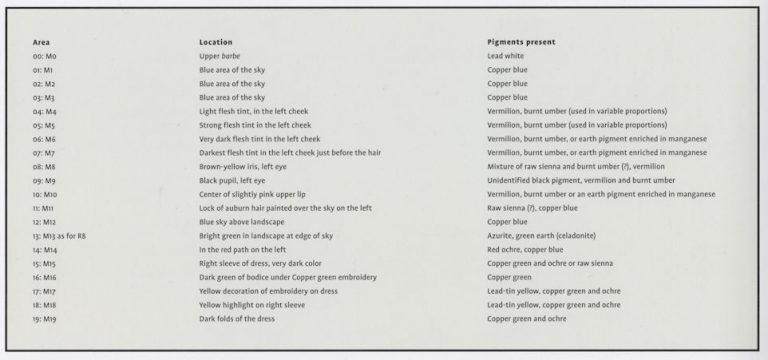



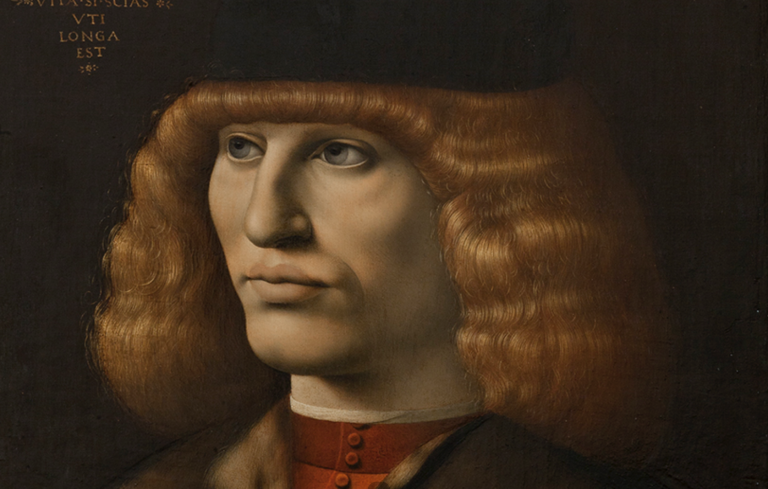

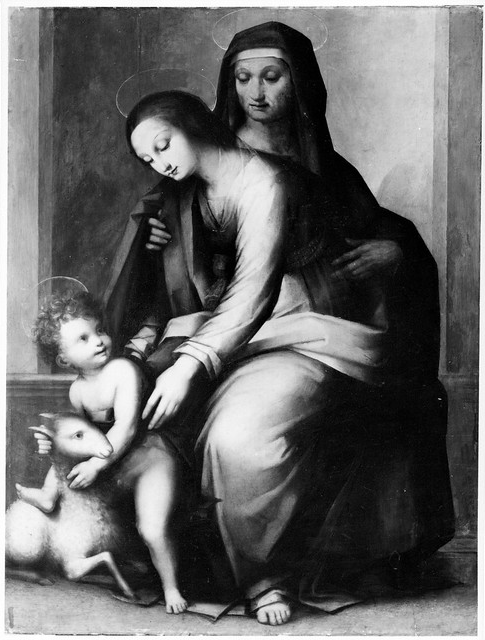
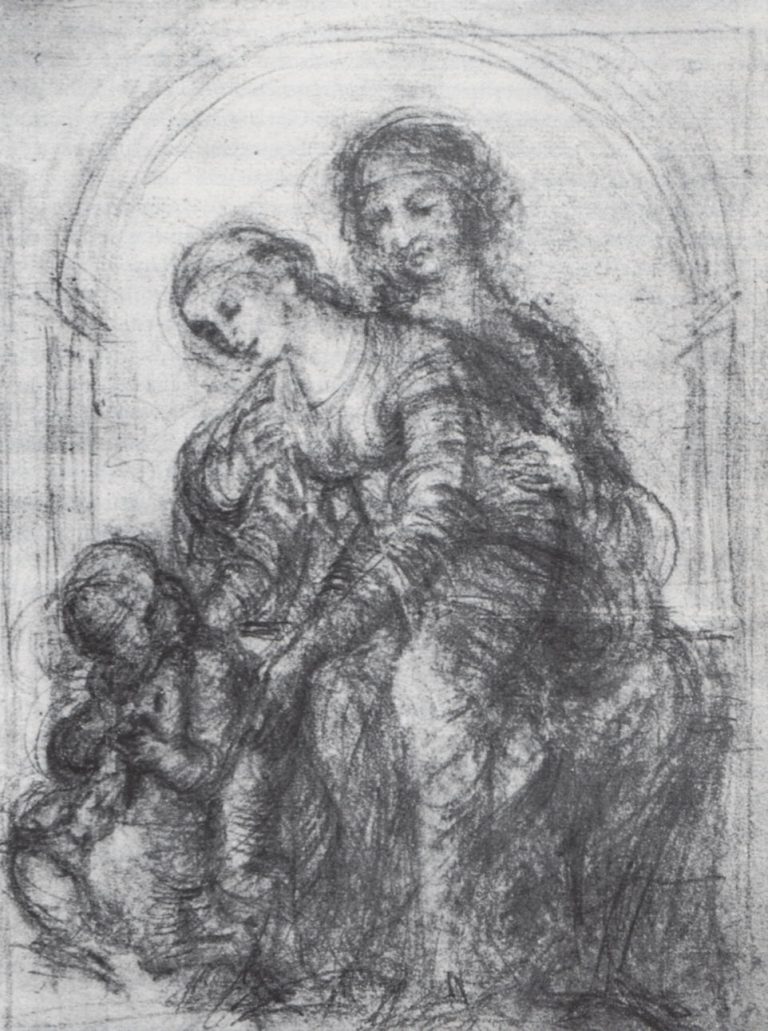
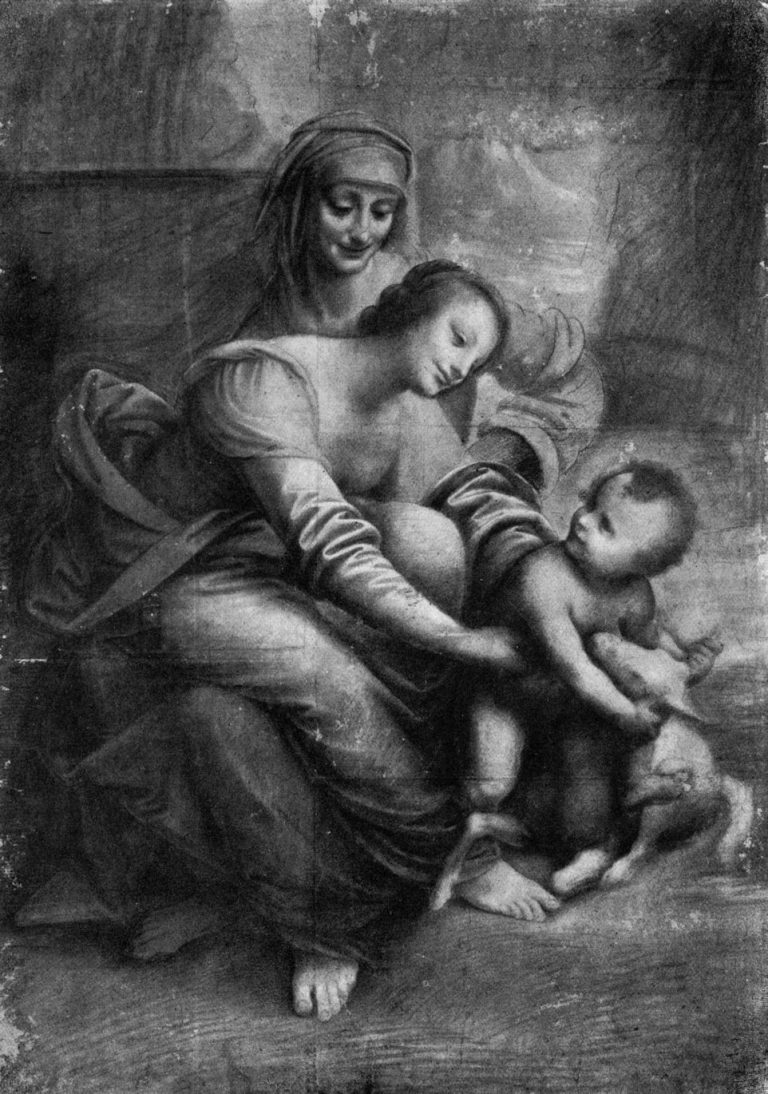
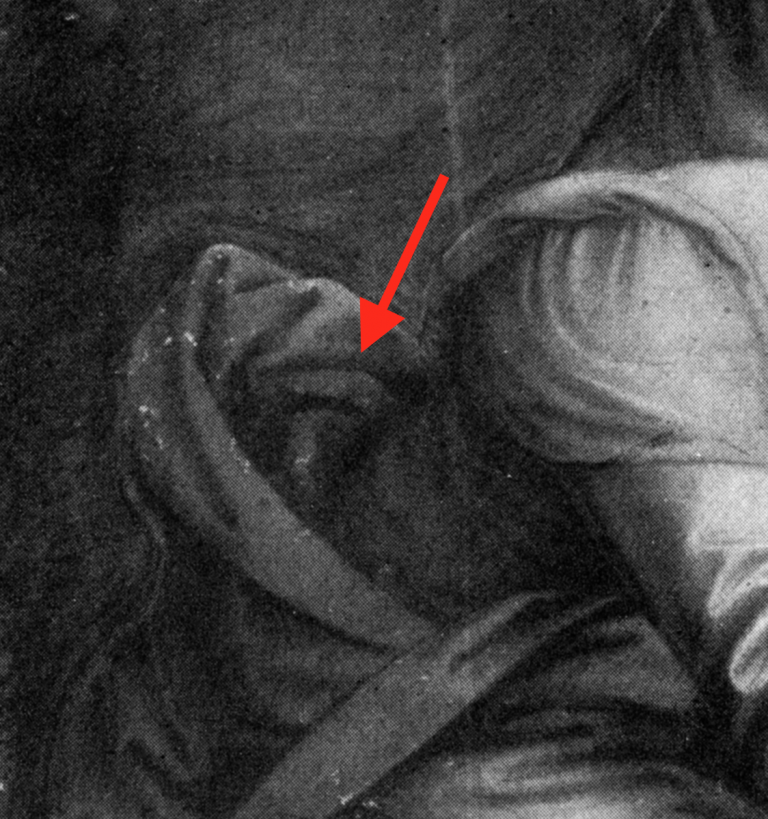



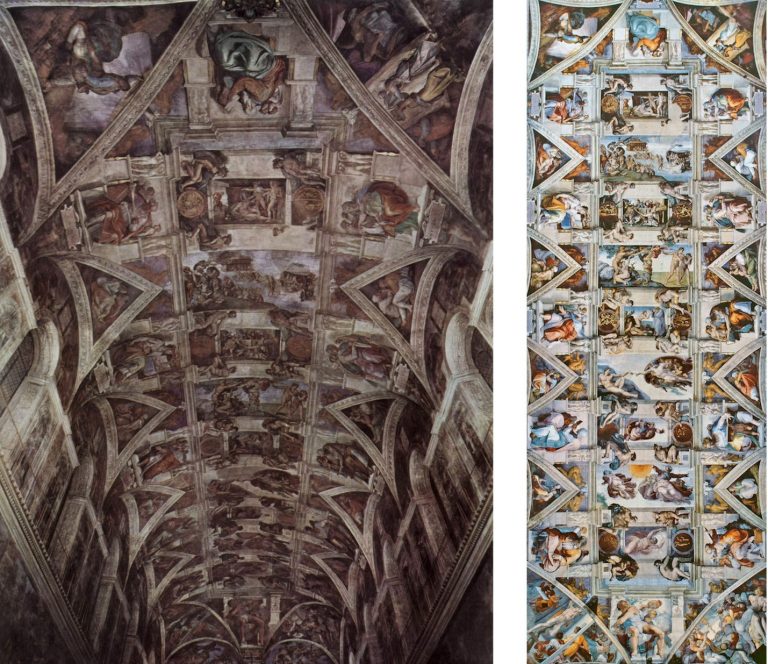
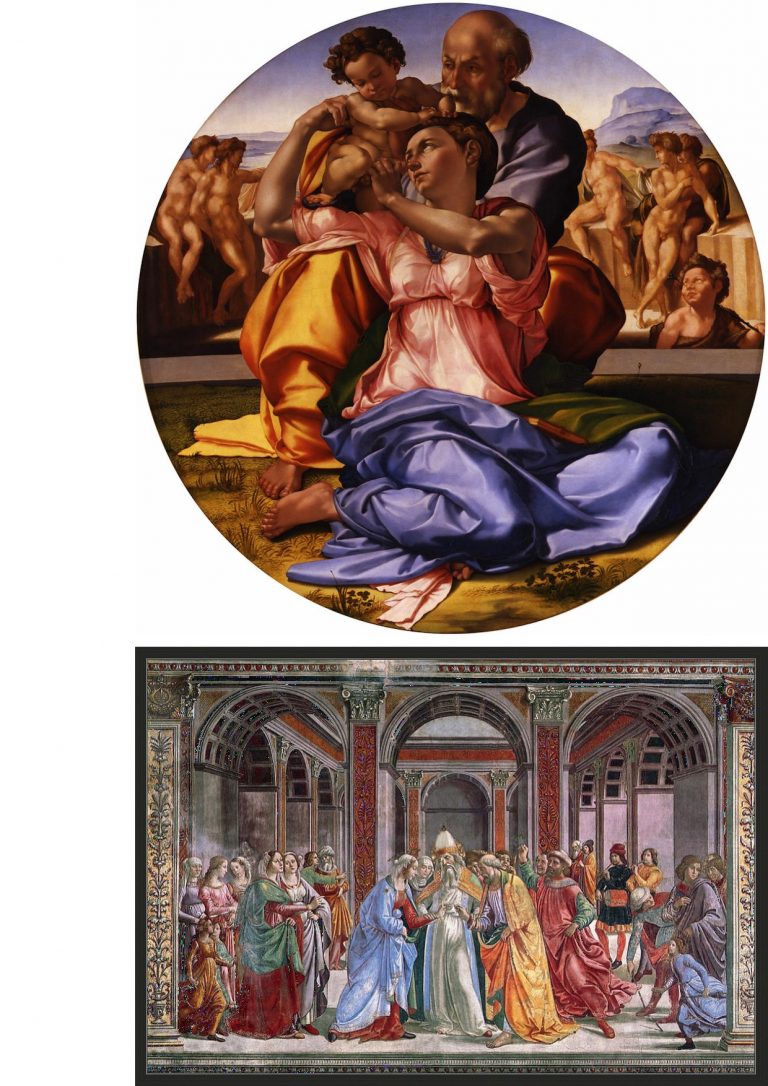
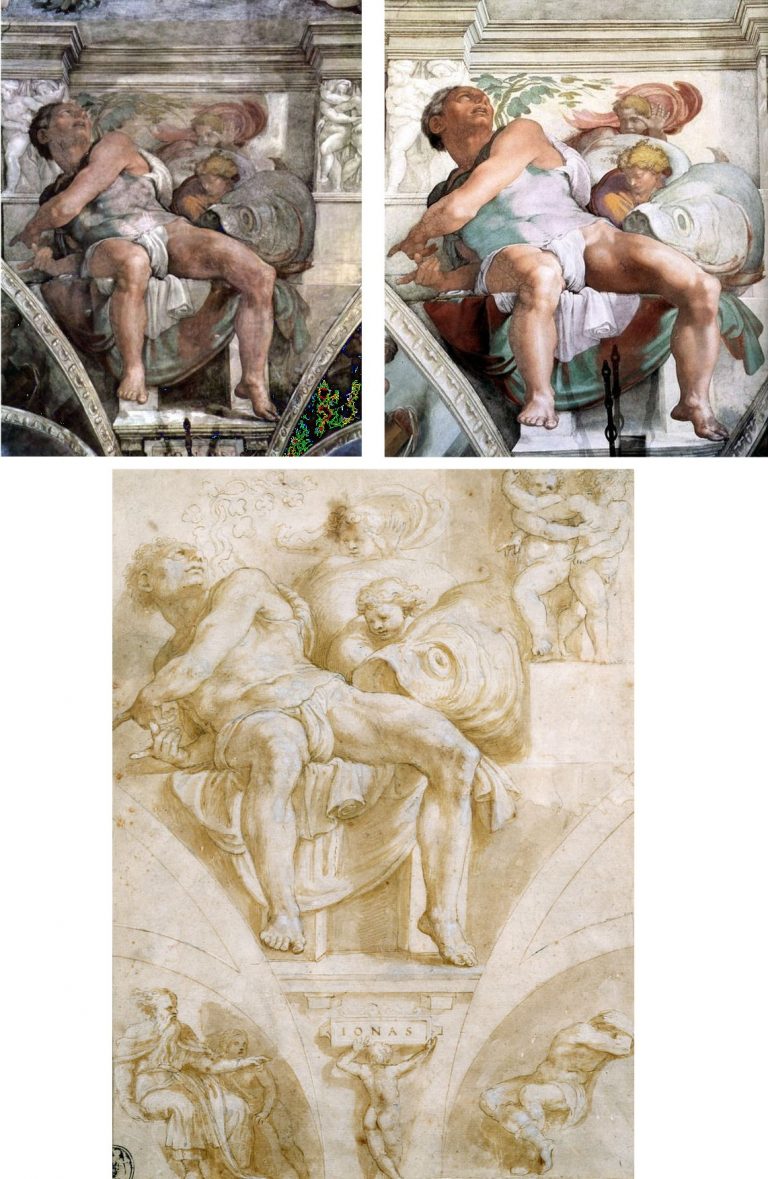
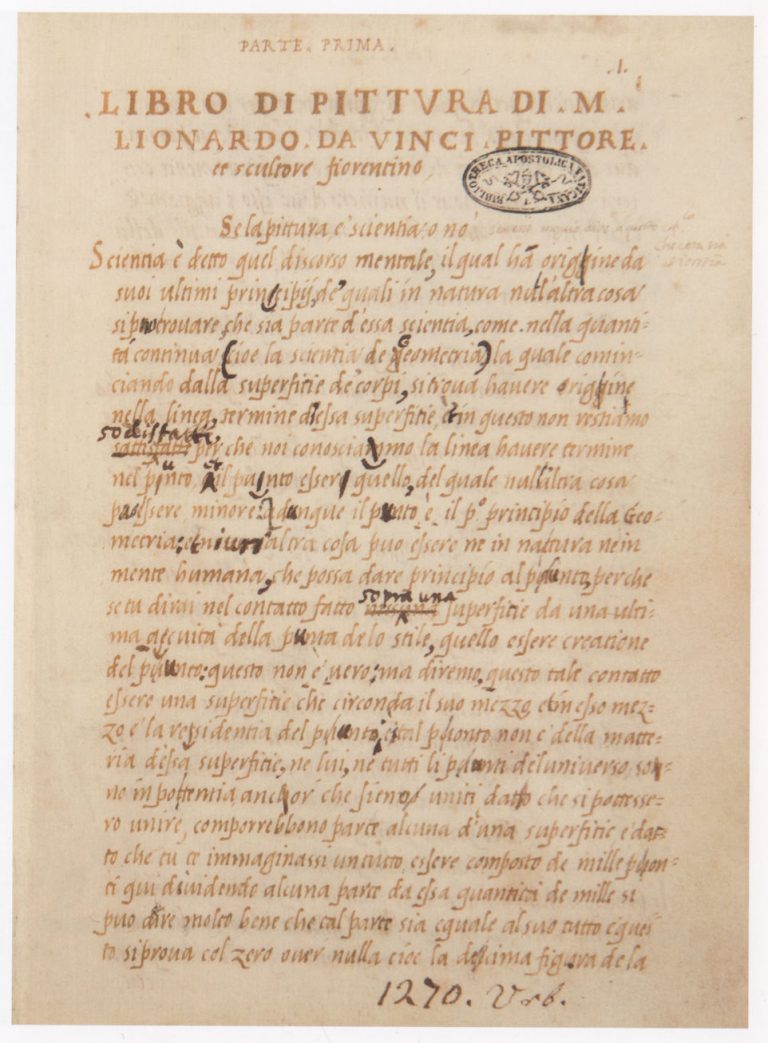
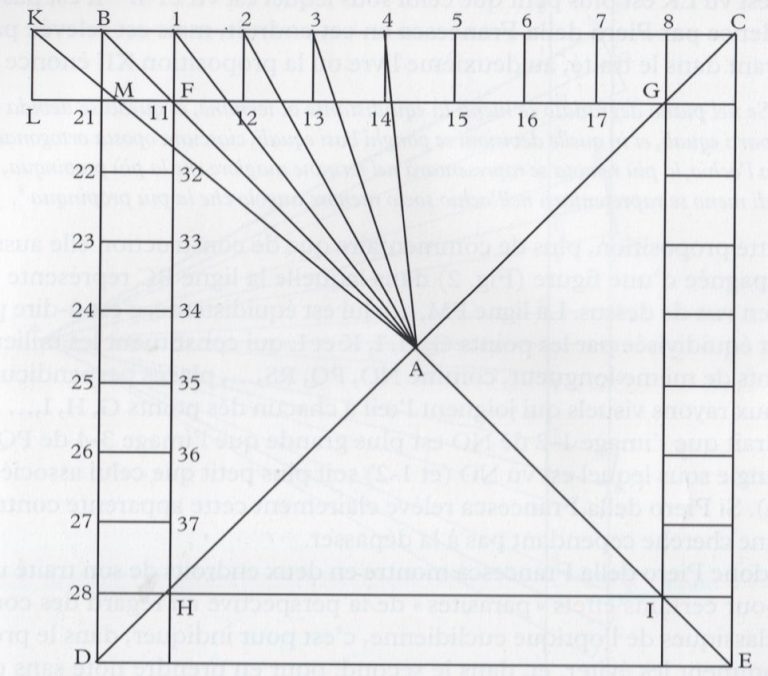

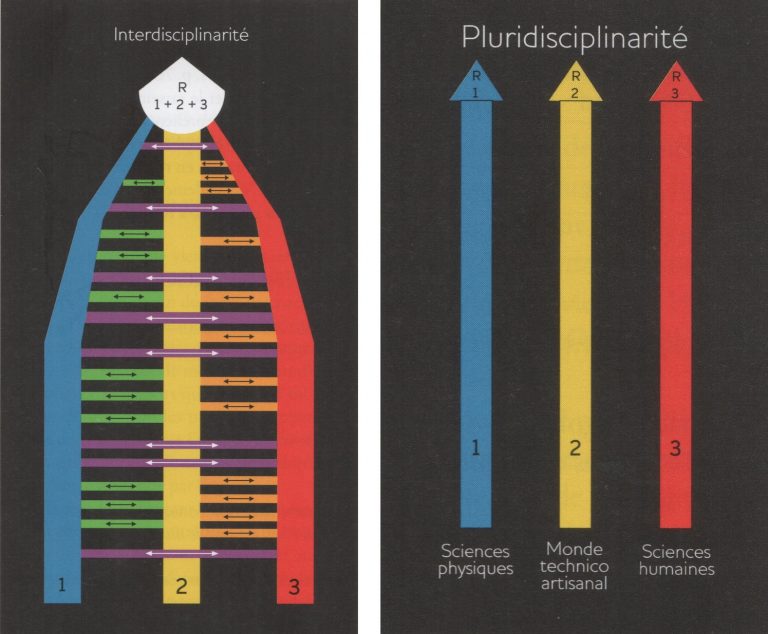

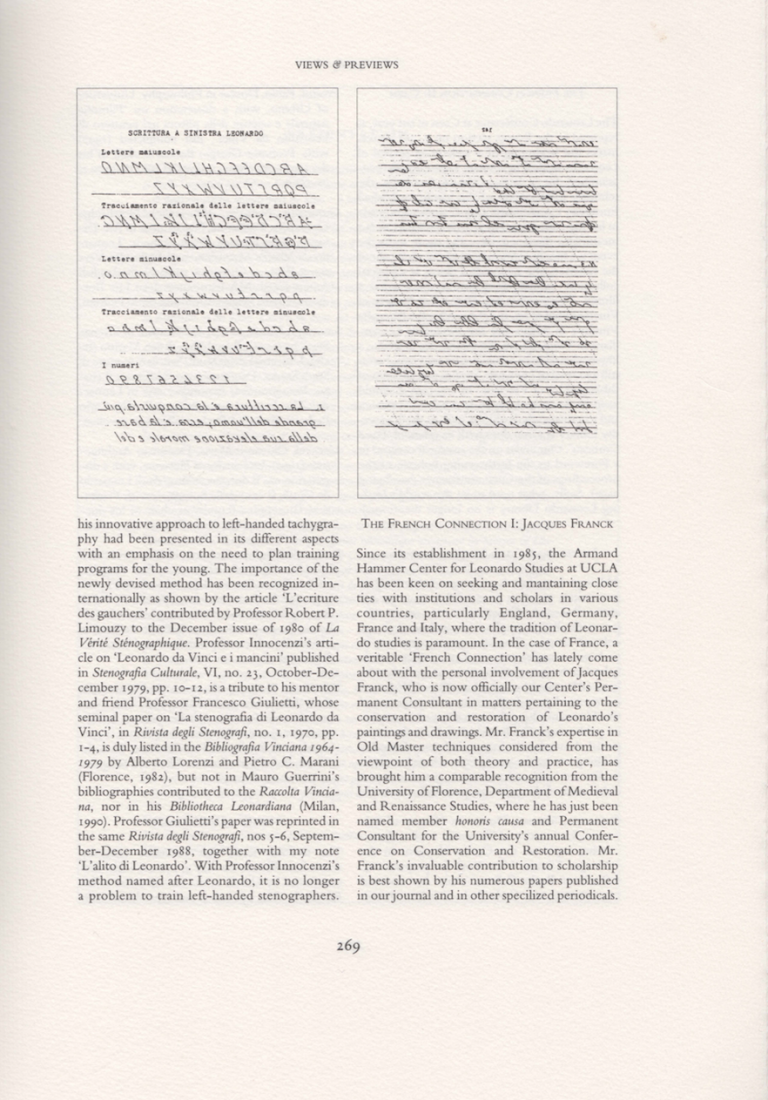
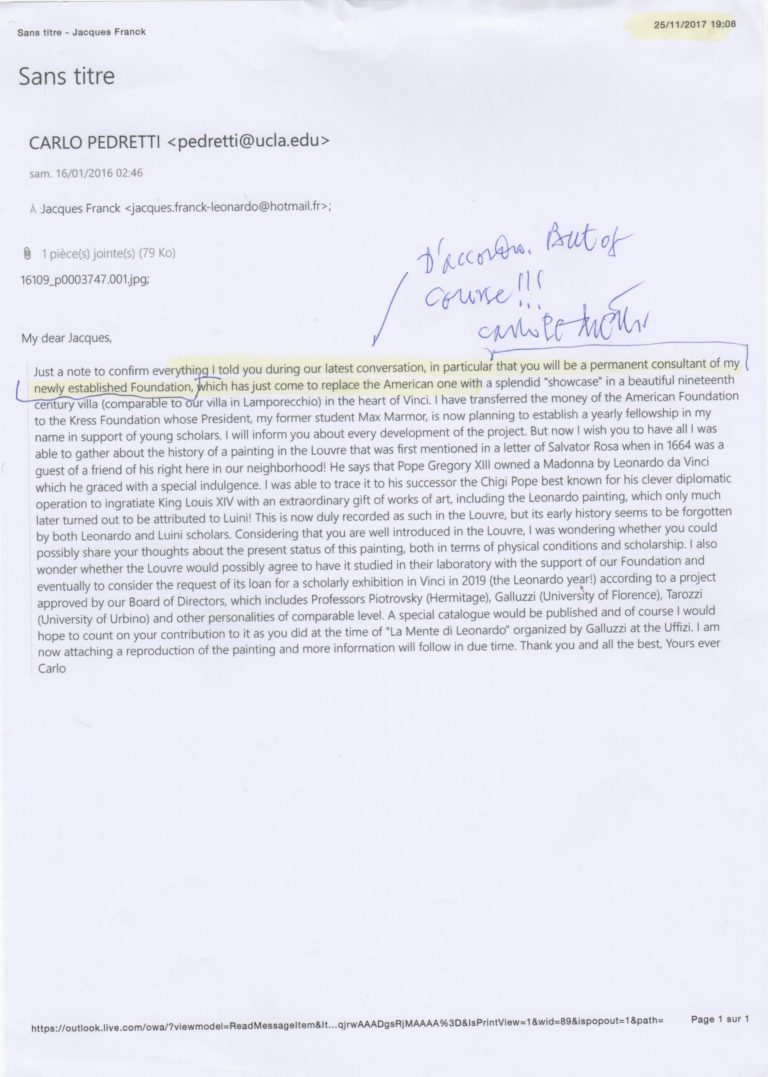

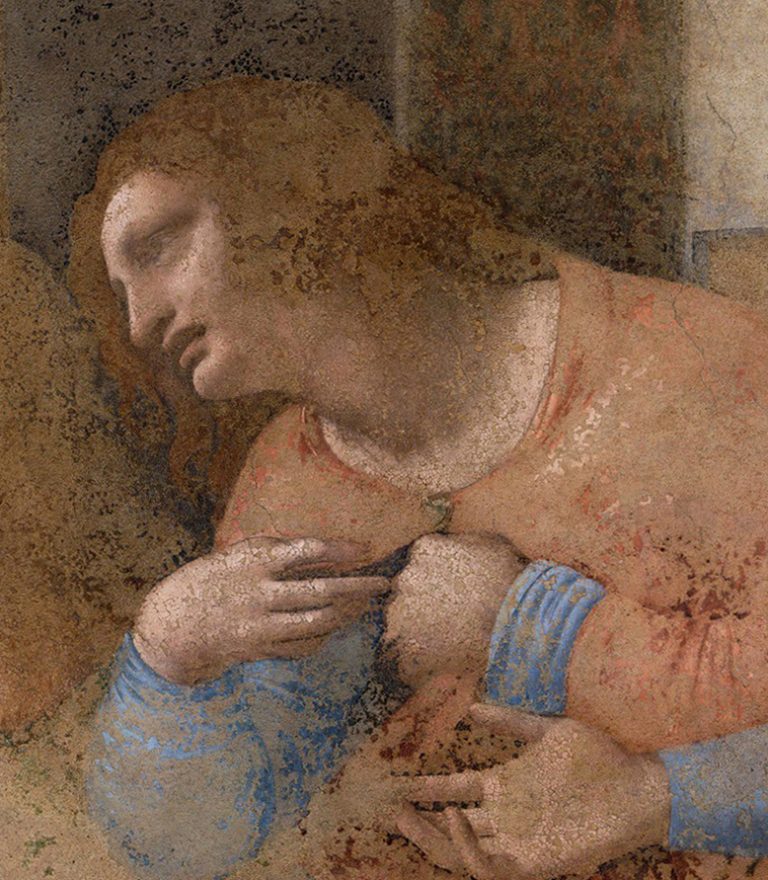
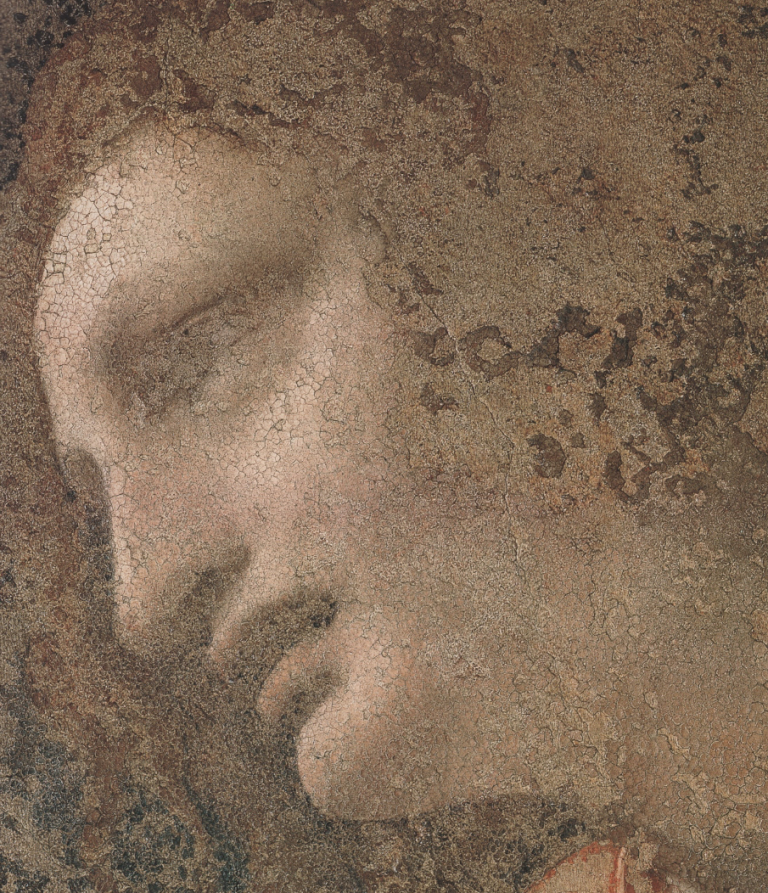

Leave a Reply